
The Project Gutenberg EBook of Water Wonders Every Child Should Know, by
Jean M. Thompson
This eBook is for the use of anyone anywhere in the United States and most
other parts of the world at no cost and with almost no restrictions
whatsoever. You may copy it, give it away or re-use it under the terms of
the Project Gutenberg License included with this eBook or online at
www.gutenberg.org. If you are not located in the United States, you'll have
to check the laws of the country where you are located before using this ebook.
Title: Water Wonders Every Child Should Know
Little Studies of Dew, Frost, Snow, Ice, and Rain
Author: Jean M. Thompson
Release Date: February 15, 2018 [EBook #56572]
Language: English
Character set encoding: UTF-8
*** START OF THIS PROJECT GUTENBERG EBOOK WATER WONDERS EVERY CHILD ***
Produced by Stephen Hutcheson and the Online Distributed
Proofreading Team at http://www.pgdp.net


A WINTER SCENE
Oh come to the window, dear brother, and see
What a change has been made in the night;
The snow is all over the big cedar tree,
And the ground, too, is covered with white.
James Taylor.
LITTLE STUDIES OF DEW,
FROST, SNOW, ICE AND RAIN
BY
JEAN M. THOMPSON
ILLUSTRATED FROM PHOTOGRAPHS
BY WILSON A. BENTLEY
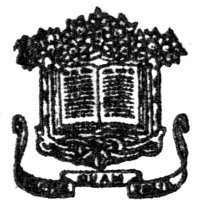
NEW YORK
GROSSET & DUNLAP
PUBLISHERS
Copyright, 1907, by
Doubleday, Page & Company
All rights reserved, including that of translation into foreign languages, including the Scandinavian
TO G. W. R.
I DEDICATE THIS LITTLE BOOK, AS AN EXPRESSION OF APPRECIATION AND ESTEEM
I am greatly indebted to Mr. Wilson A. Bentley for valuable assistance in the arrangement of this book, and particularly for permission to reproduce the microphotographs. Jean M. Thompson.

3. Grass blade with dew deposit—three drops held in suspension on top of blade
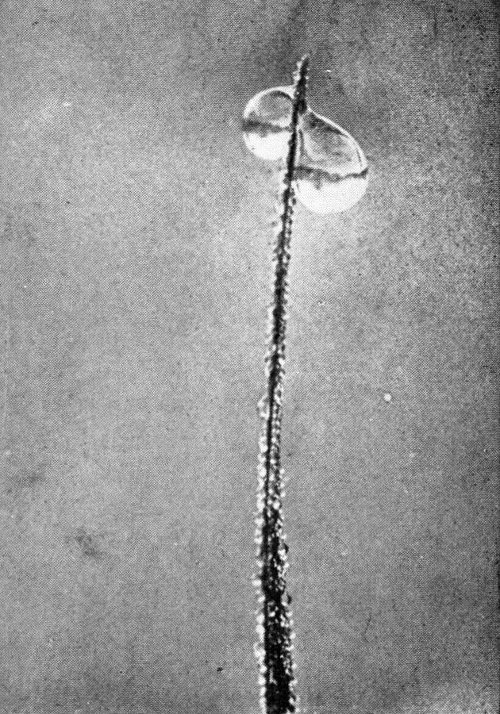
4. Showing how sharp pointed grasses collect and retain the dew drops, while blunt or broken blades collect none
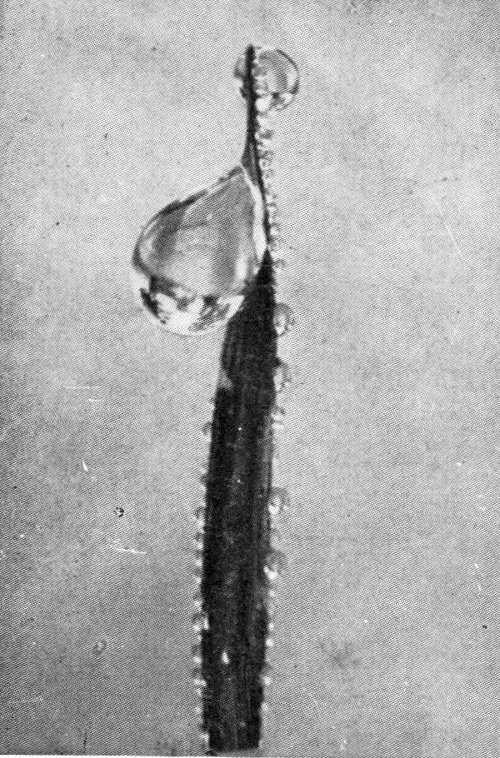
5. Grass-blade holding two drops—dew drop preparing to fall

6. Dew drops on grass blade; showing inverted landscape held in drop
“Everything shone with the dew drops that sparkling and trembling lay
Scattered to left and to right, and the webs of the spiders were hung
Thickly with pearls and diamonds; light in the wind they swung.”
One of the most interesting and instructive phenomena in the lessons of nature is the falling of the dew—a seeming miracle which begins with the setting of the sun, and goes on mysteriously, collecting and distributing its countless exquisite water jewels, all through the long stillness of the night, only to be dispelled again by the heat of the rising sun.
We are more or less familiar, through casual observation, with the varied beauties of the dew. A walk in the country or park, in the early midsummer morning, just after the sun has risen, if possible, will enable you fully to appreciate its charms; especially if the dewfall during the preceding night has been a copious one. Every bit of plant-life and vegetation will sparkle and twinkle in the early sunshine, hung and embellished with millions of glittering jewels. The very smallest grass blade, you will discover, has not been neglected by the Dew Fairy. And even the delicate, gossamer-like spider’s web swung from twig to twig or caught among the grasses, is dew laden, and an object of beauty well worthy of consideration.

7. Spider’s web entire: showing manner of collecting dew
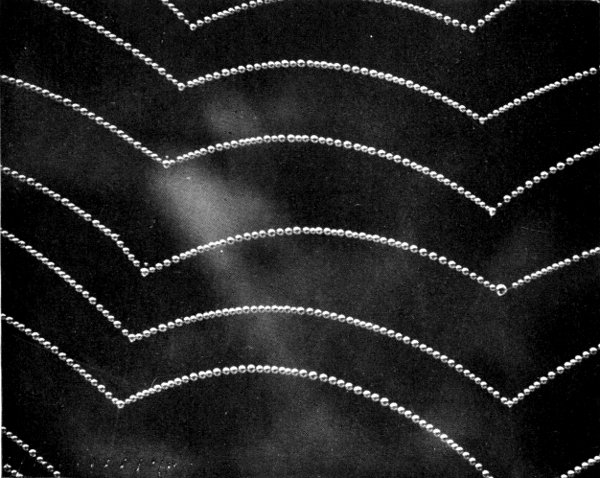
8. Detail of spider’s web dew-laden. Observe the pearl-like strands.
Happy indeed are you, if you have enjoyed a stroll in an old-fashioned country flower garden in the early morning. No need to dwell upon its charms if you have enjoyed that pleasure, for you will long remember the refreshment and peace which came to you with the close companionship of the great pink, damask roses, their petals still heavy with the night dews; the tall, sentinel-like lilies, cool and fragrant, their cups filled with dewy nectar, which great blundering bees were eagerly plundering; clean-smelling phlox, waist-high, each velvet cluster moist and bent with its weight of dew. Then the beds of gray-green mignonette; and best of all, down in an out-of-the-way corner, a tangle of unobtrusive old-fashioned pinks, where you knelt and buried your face for a moment to inhale their spicy fragrance, and found them doubly sweet and satisfying after their drenching dew bath. While the beds of simples and humbler things, the sage and wormwood, with their silvery leaves heavy with dew, exhaled a pungent, aromatic odour as you brushed them in passing. For the dew had refreshed them and enhanced their dormant spiciness tenfold.
The phenomenon of the dew is simply explained, and well worthy of a short study as it is really a most important factor in nature’s laws. Simply explained, the dew is really an actual deposit of water from the atmosphere upon the surface of the earth, and is formed when the earth is sufficiently cooled during the night by radiation.
Upon a pleasant day during summer, especially if the sun shines brightly, much aqueous vapour or mist is held suspended in the air, and if the temperature at sunset falls below the dew point, that vapour can no longer be retained in suspension in the air, and falls to the earth. The dew is the vapour of the air. Sometimes it can readily be seen falling in a fine mist resembling rain. It is the humidity of the air deposited upon all surfaces of the earth with which it comes in contact. When the temperature falls below the dew point, or 32°, the dew then becomes converted into frost, and we have a deposit of hoar frost, instead of the dew. It has been remarked that horizontal and flat surfaces exposed to the dew receive a greater deposit than sheltered or oblique surfaces.

9. A dew-laden strawberry leaf with dew jewels set in each serration about the edges
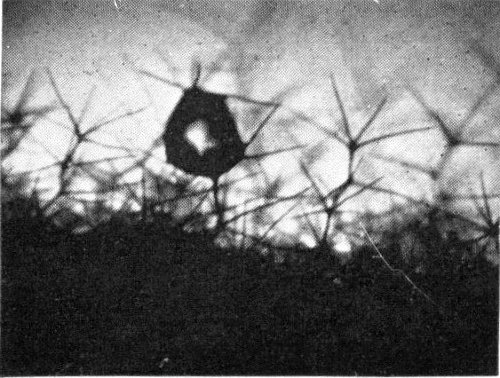
10. Dew drop caught on vegetable hairs of mullein leaf
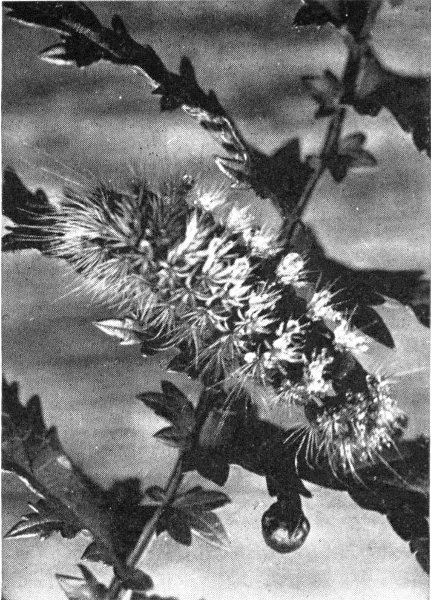
11. The sleeping caterpillar was a good subject and received a copious collection of dew
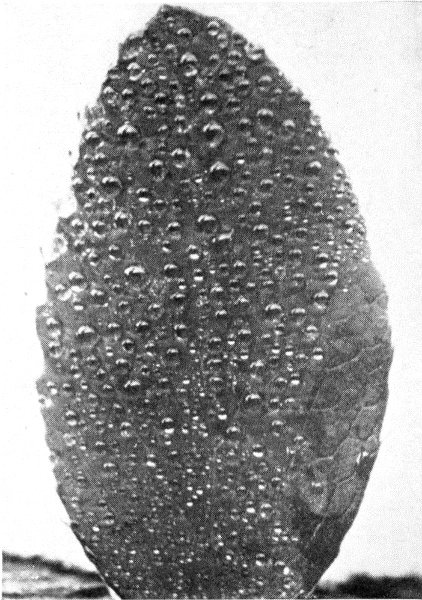
12. The surface of a leaf dew-covered
Dew has frequently been quoted as “A shower from heaven,” but this is not literally correct. True, it appears rather mysteriously from a clear sky, and upon a still, cloudless night covers thickly every blade of grass and plant life with seeming raindrops, and that frequently where rain clouds rarely appear, and the rain seldom falls. In such climates, where a rainfall is rare, it is certainly a most beneficial and wise provision, for it gathers upon all herbage and vegetation, in sparkling, refreshing profusion; while it avoids instinctively all barren rocky formations and all things which could not be benefited by its grateful cooling, moisture. Also, in cold, damp climates, where the air is continually saturated with moisture, and where an additional amount is not required, the gathering clouds and the dampness of the chilly atmosphere prevent a radiation of heat from the earth, and the dew never falls in such climates.
There are three requisites which appear to be essential for the formation of the dew: First, that the air should be moist; second, that the surface upon which it falls shall be cold, and third, that the sky be clear.
Of course the atmosphere always contains a greater amount of moisture after a rainfall, when the air has been greatly cooled. Evaporation is then continually going on among all objects lying near the surface of the earth. Blades of grass and all plants near the ground gradually cool and assume a lower temperature after sunset; they are preparing for the fall of the dew.
It has been remarked that certain plants possess greater powers of radiating heat and of expelling moisture through evaporative process than others; upon such plants the dew deposit is always more profuse, while those plants possessing less powers of radiation and evaporation, collect little dew.

13. Dew caught and held upon down of plant stem

14. Dew upon the down of a leaf
There are very many plants whose leaves are downy, with a thick growth of tiny vegetable hairs; the mullein leaf is a good example, its thick velvety leaves are thickly covered with this growth of vegetable down, and present a velvety surface; these leaves always collect a fine display of dew jewels. One has been caught by the camera, perched upon the down of a mullein leaf, as shown in the photographic illustration.
During still nights in early spring and fall, when there are no disturbing winds, the water molecules or dewdrops in countless numbers form one upon another, all night long, and settle upon blades of grass and all growing plants, and in the morning sunshine dance and sparkle in strings of scintillating diamonds from every pasture and hedge row.
The sharp-pointed grasses collect the dew very copiously and in a most interesting manner. Dewdrops formed upon the grass blades, it will be observed, are arranged in a truly wonderful symmetrical fashion, and one marvels at the orderly arrangement. Frequently one large dewdrop, clear as a diamond, is deposited upon the very tip of the little grass blade, sometimes two and even three large drops are held in suspension thus, while upon the extreme sharp edge of one or both sides of the blade a collection of small, bead-like drops cling in orderly, precise fashion, strung from tip to root of the grass blade. A broken or blunted blade of grass collects no dew, or very little. When the large dewdrop perched upon the tip of the grass blade decides to fall, it descends rather slowly at first, following the extreme edge of the blade in its course, and thus meets and collects all the other dewdrops which it encounters strung along the edge of the blade, until forming at last one heavy drop, it suddenly falls to earth, where it is instantly absorbed, and goes to give life and strength to the very roots of the plant.

17. Hoar frost deposit upon a stick. The butterflies have settled to rest
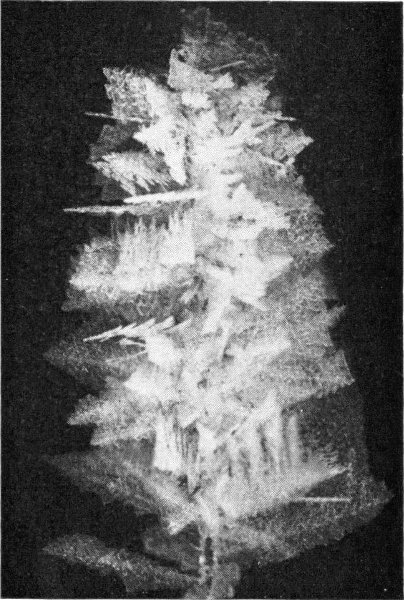
18. Dainty lace-like formation of hoar frost collected upon a straw
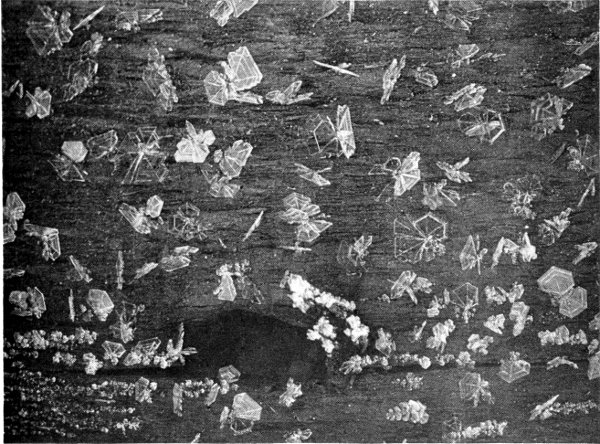
19. Winter tabular hoar frost resembling a group of butterflies
Cobwebs attract the dew in a rather singular manner. It is yet to be discovered why the dew forms only upon the horizontal threads of a spider’s web, while the vertical threads, though smaller, collect no dew deposit. This curious fact is well shown in the photograph of the entire spider’s web, also in the section of a web, showing the dew deposit in detail. Wonderfully beautiful are these dew-laden webs. It will be observed that each drop is similar in size, and closely resembles several strings of well-matched pearls, although in the sunshine they appear as clear, flashing diamonds. Certain leaves collect the dew drops in a novel manner, notably the strawberry leaf, and similar plants having serrate edges. The strawberry leaf, besides being plentifully decorated upon its surface with water beads, holds in each tiny serration about its edge a large, clear, sparkling dewdrop, which gives the leaf a wonderful jewelled effect.
We are all familiar with the so-called “sweating” of a glass or pitcher, or a metal pipe containing cold water; this is another phase of the dew, and may be observed in the daytime.
A cool night in spring or autumn, after a hot day, we usually receive a more copious fall of dew, which gradually increases as the night becomes cooler. Should clouds gather, the precipitation of the dew at once ceases. Wherever a bush or bit of vegetation overhangs a spot, it has a similar effect to that of a cloud, and the dew does not collect at all, or not as copiously, in that spot.
In the tropics, and in certain countries where there are no rain clouds; where they rarely have rain for many months at a time, the dewfall is so heavy that it quite supplies the lack of rainfall. If it were not for this providential visitation of the dew all vegetable life must certainly perish, scorched and withered by the torrid heat.

20. Like a piece of bleached coral. Hoar frost discovered under a building
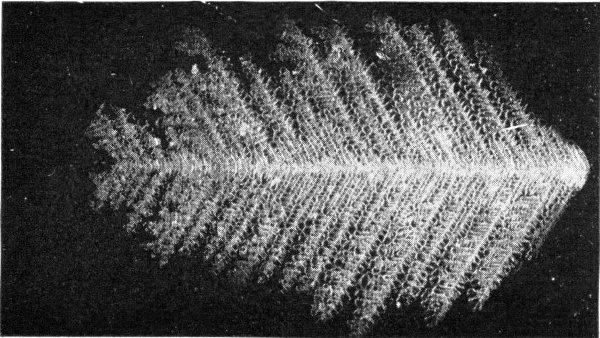
21. Tabular hoar frost
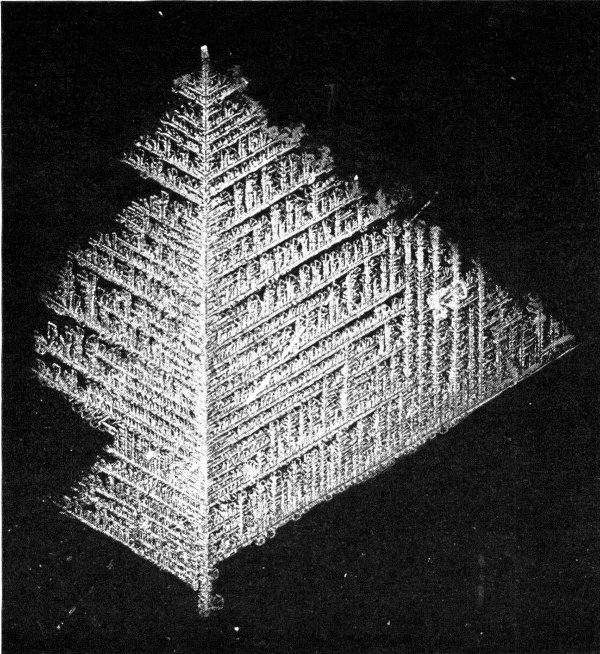
22. Tree form tabular hoar frost: grew in zero weather
In the East, in the region of Palestine, the dew frequently is so heavy that it closely resembles rain. Upon the great burning deserts alone the dew never falls; for the moment the dew vapours or molecules encounter the scorching breath which arises from the face of these barren seas of sand, they evaporate and are redissolved, dissipated and consumed by the heat. So it will be seen that the fixed molecules which compose vegetation alone have the power to attract and arrest the water molecules of the air with which they come in contact, and thus form, in combination, the dew.
When the temperature is below 32°, the tiny particles which go to form the dew become hoar frost. It is often of great value to the farmer or vegetable grower to be able to know just the temperature of the dew point, because, if he discovers it in time, he is enabled to save his garden from a sudden blighting visitation of the frost.
Another interesting fact, and one which is known to few of us, but which may readily be seen, if we take time to study the dewdrop minutely is; that each tiny drop of dew is in itself a miniature mirror, for upon its clear, crystal-like surface it holds and faithfully portrays upon its rounded form the image of any near-by object. The picture is, of course, naturally inverted. But you will find it; a bit of blue sky holding a scrap of fleecy cloud, or a pigmy forest of trees caught and mirrored in the dewdrop. Often sleeping and dormant insects when caught out in the open during the night, receive a copious deposit of dew. The caterpillar shown in the photograph was a good subject, and quite a collection of dew was deposited upon his furry coat.

23. A Winter type of hoar frost
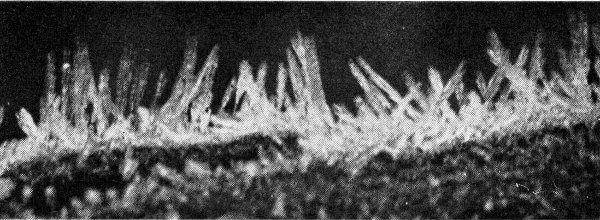
24. Columnar hoar frost upon a decaying log
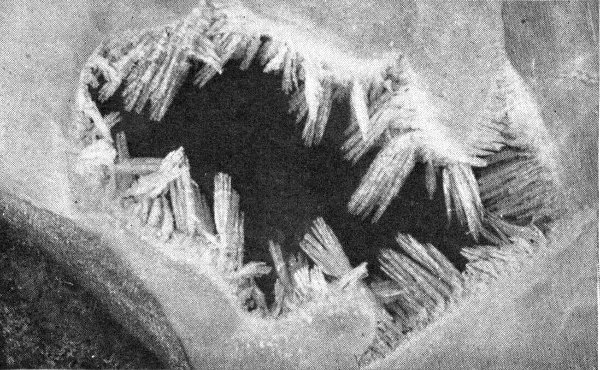
25. Striking arrangement of hoar-frost crystals upon broken edge of ice, water showing beneath
Nature in all her moods, and they are many, is always entertaining and instructive, and perhaps one of her greatest marvels is that which takes place in the silence of the brooding night—the falling of the gentle dew.

26. Showing hoar-frost elaboration about the edge of a leaf
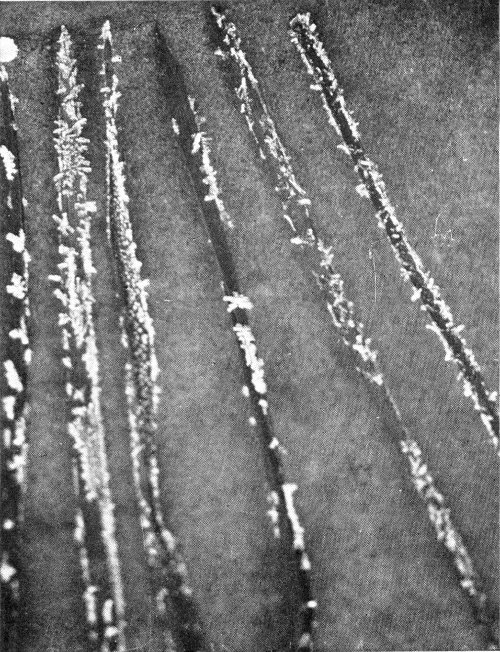
27. Hoar-frost deposit upon grass blades

28. Moss-like hoar frost deposited upon surface of pond

29. Columnar hoar frost scattered over brook ice
“Rustily creak the crickets;
Jack Frost came down last night—
He came on the wings of a star beam,
Cool and sparkling and bright;
He sought in the grass for the crickets
With delicate icy spear,
So sharp and so fine and so fatal,
And he stabbed them far and near.
Pray what have you done to the flowers?
Where hides the wood aster?
She vanished as snow wreathes dissolve in the sun
The moment you touched her.”
—Thaxter.
When autumn has reached the zenith of perfection, when the milkweeds and thistles which grow thick in the hedges have cast their gossamer, fairy-like seeds to the winds, and the goldenrod which flaunted its yellow banners so brightly through those last long, perfect days of dying autumn, has at last begun to fade, the first warning which we have of the approach of the frost is all at once seen in certain mysterious changes of colour which have taken place in the foliage of the trees. Then we know that upon that last still night, when the stars snapped and sparkled so brilliantly, and the air felt unusually keen and crisp, that the Hoar-frost Spirit must have been abroad, and in passing, touched all the trees and plants very lightly with his magic wand. Out in the garden the sturdy sunflowers droop their seed-filled crowns a trifle, while the hollyhocks seem to stand less primly and firmly, and lean together as though for support. They have felt the blighting touch of that magic wand. He touched also the tips of the maple leaves upon the hillside, and left upon some of them just a little dab of his crimson brushwork; they form a touch of brilliant colour against the darkly massed pines and hemlocks in the background. But shortly they will flame forth upon every hillside, one vast torch, lighted to do honour to the passing of autumn; and all the work of the Frost Spirit.

30. An odd hoar-frost formation
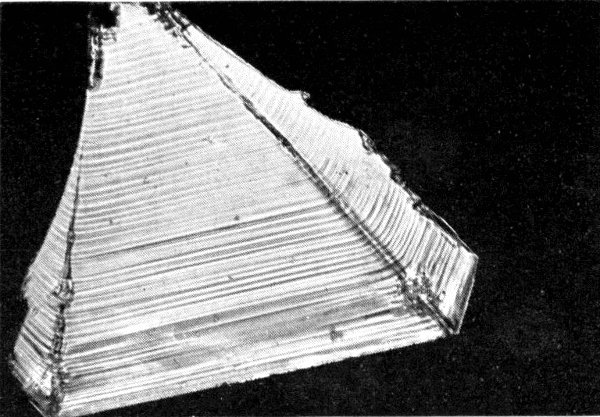
31. Detailed tabular hoar frost—grew slowly
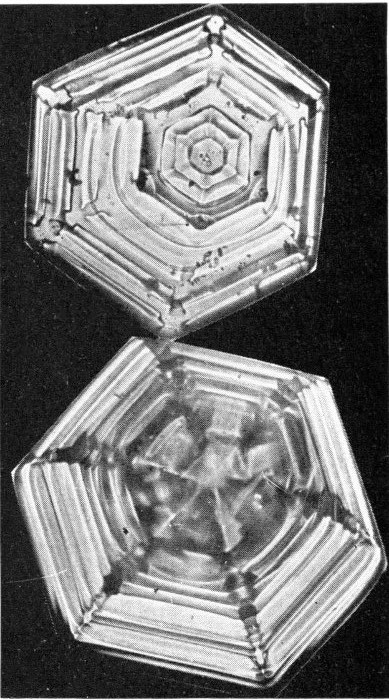
32. Detailed tabular hoar-frost crystals
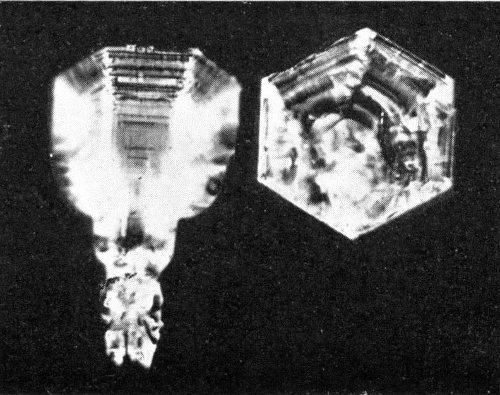
33. Cup form hoar frost
The little sour fox-grapes which grow in the hedge-rows, are now piquant in flavour, and have acquired something which they lacked before, and are pleasant to the taste since the hoar frost’s visit to them. The bitter-sweet berries which grow close beside them, tangled and twisted with the gray, fluffed-out clematis plumes, have burst their orange-coloured sheaths, and gleam more vividly than before. And the great green chestnut burs are bursting, just a trifle; they need one more, slightly sharper touch from the hoar frost, and then the plump, brown, satin-skinned nuts will come tumbling out of their burs to the ground. The eager squirrels have already begun to collect their winter supplies. They are early at work, even before the magical display created by the hoar frost has been touched by the sun. They mean to get ahead of the children in their nut gathering, if possible.
If you too, would rise with the squirrels, and go forth into the open fields and woods, you will be amply repaid for the small effort which it cost you, for the display which the delicate hoar frost makes upon a clear morning in early autumn, when first touched by the sunrise, is really fantastic and wonderfully beautiful.
If you happen to be in the country, direct your steps across the pasture lands, where the short thick grass is powdered heavily with the hoar frost, and do not fail to pause at the old, gray rail fence, leading into the cornfield, to study the fine effects, the magic work which the Frost Spirit has left there during the night. The withered brown shocks of corn, standing in suggestive, witch-like attitudes, scattered over the fields, each lance-like rustling blade tipped with a steely, glittering coat of frost; while between the leaning stacks gleam great golden pumpkins, as yet unharvested, each golden sphere gleaming through a bluish-white deposit of hoar frost, or frozen dew.

34a. Columnar hoar-frost crystals
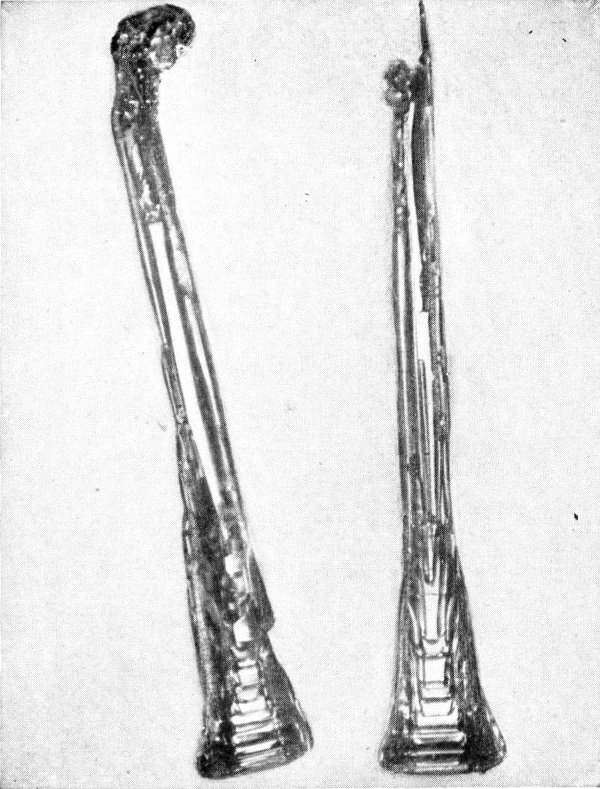
34b. Columnar hoar frost (tabular)
Unquestionably, James Whitcomb Riley had in mind a similar scene when he was inspired to pen the homely lines so often quoted:
“When the frost is on the punkin,
And the fodder’s in the shock.”
The beauties and peculiarities of the hoar-frost crystals are a distinctly separate study in themselves, as they do not belong, nor are they classified with the heavier frosts of late and mid-winter, such as we find in the extreme cold weather deposited upon our window-panes and elsewhere.
The hoar frost is in reality the dew particles or molecules of water in the air, which, when the temperature falls below 32°, freezes and collects, and thus forms a deposit of hoar frost upon nearly all surfaces which it encounters.
Still another variety of hoar frost is that which forms mysteriously under some covering; occasionally we find it deposited upon a bit of wood which has lain under the snow; it forms upon the underside of the wood, or that part resting upon the ground, and is caused by the moisture of the earth, which collects, and which the temperature converts into crystals of hoar frost.
Special and interesting examples of hoar-frost formations are given in the photographic illustrations, which, being taken with a camera having a microscopic attachment are, for the most part, largely magnified. The detail and formation of the hoar-frost crystal is most delicate, and well worthy of study, and the curious manner in which some of them are found, also the many different shapes which they assume, clearly shows that each formation is possessed of certain individuality of structural form peculiar to its environments, and the surrounding objects to which it may attach itself.

35. Linear window-pane frost. A common type

36. Showing initials crudely scratched upon glass, which frost has elaborated
An especially interesting type of crystal is that which grows in queer needle-like layers, somewhat suggestive of tiny stalactite growths; this variety we frequently discover in gravelly or peaty soil, while it sometimes raises and supports upon its points large sections of earth and stones.
These needle-like columnar formations, which are excellently portrayed in the illustrations, are often found from two to six inches in height, and are formed from the moisture which rises from the warm soil and freezes. These columnar crystals do not form in this manner in the extremely cold weather, or after the ground has become solidly frozen to a certain depth; therefore they may be classed among the hoar-frost formations of early autumn.
As shown in detail in the photographs, the formation of each section of this type of hoar-frost crystal appears as a prism-like columnar growth, the base of the prism being hexagonal in shape, and closely resembling an unset jewel.
Through the still, cool nights in autumn the Hoar-frost Fairy works steadily, covering vegetation with glittering frost-work, touching all unsightly places, decaying woods, old gray fence-rails lightly in passing, and upon the following morning, if you are fortunately stirring before the sun ruins the best work of the hoar frost, you will discover many wonderful works of art. Sometimes it will be a miniature, scintillating forest of needle-like crystals attaching itself to some old rail. Again a perfectly marvellous collection which you may find deposited upon a board; tiny tabular ice crystals of hoar frost closely resembling a flight of white butterflies or moths powdered over its flat surface. We were fortunately able to secure one of this type; and with the aid of a small pocket microscope, you may be able to discover this pleasing variety, as shown in our photograph. The same variety of hoar frost was again encountered, where the delicate crystals had formed and grouped themselves upon a stick or straw; this is wonderfully suggestive of a group of butterflies resting upon a flower-stalk, as we frequently observe them in mid-summer, where flights of the yellow wayside butterflies assemble upon a mullein-stalk in precisely the same fashion.

37. An exquisite lace pattern in frost
The showy illustration resembling in formation a branch of bleached coral, is another interesting example of the hoar frost’s eccentric development, and was found clinging to a decaying beam, under an old building.
The beautiful feathery spray, somewhat resembling a miniature fir tree, was taken from the branch of a tree, about which it had formed, and is made up of countless, lace-like, filmy ice prisms, of infinite delicacy.
Much is lost in the scintillating iridescence of these frail hoar-frost crystals when seen merely in the photographs, for they frequently show rare colour effects when seen in the open.
That the hoar frost sometimes takes strange freaks is shown in the exquisitely beautiful deposits occasionally found upon the edges of a piece of broken ice. Sometimes you will discover it upon the thin, new ice which forms upon small streams in the early autumn, and in gullies beside the road. This ice is short-lived, and readily breaks at the slightest touch, with the crackling sound of broken glass. A section of this thin ice is shown, about the ragged edge of which the hoar frost has arranged itself in fantastic fashion. The dark waters of the brook may be seen through the opening.

38. A beautiful example of two distinct types.
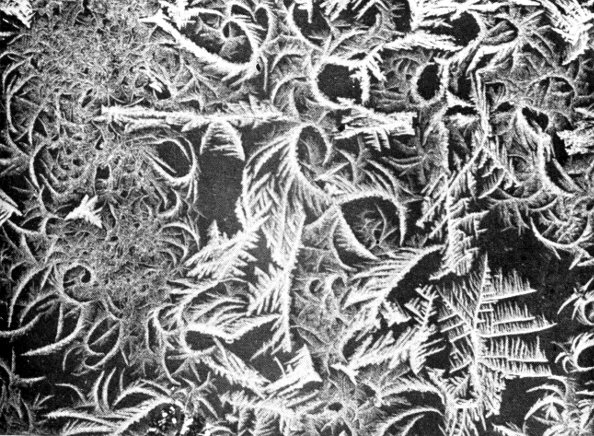
39. Fern-like scrolls, delicate background.
Hoar frost which gathers upon the grass blades, unlike the deposit of the dew, does not form noticeably upon the tips of the blades; on the contrary, the hoar frost gathers in an apparently greater and heavier degree the nearer to the earth it approaches. Flat-leaved, low-growing plants are usually well covered with hoar-frost crystals, while about the edges of certain leaves a heavy decoration of film-like crystals is sometimes seen.
Frequently upon a pond of frozen water we come across a queer moss-like fungus deposit scattered at intervals over the surface of the ice. This is still another type of hoar-frost formation. Still another is the columnar frost crystal, which is formed of clusters of needles, and these loose, needle-like formations we frequently find scattered over the surface of thin brook ice.
During your rambles in the autumn, after the arrival of the hoar frost, it would prove a pastime as well as an instructive nature study, to search out and locate the many different varieties of hoar frost. Be sure to take a small pocket microscope or reading lens with you. Search diligently in unexpected places, beneath blocks of wood, about decaying logs and old tree stumps, for in all sorts of out of the way places you will encounter them. Under the edge of a stone, imbedded even in the snow, and scattered over the surface of frozen pond and brook. The Frost Spirit seeks all sorts of strange nooks and crannies in which to deposit its fascinating mushroom growths.
Nature has in store for us many strange, agreeable surprises. Among them there is much to be discovered and learned about these delicate fantastic creations deposited by the Hoar-frost Spirit.

40. A perfect fern leaf

41. Raised fern-like arrangement
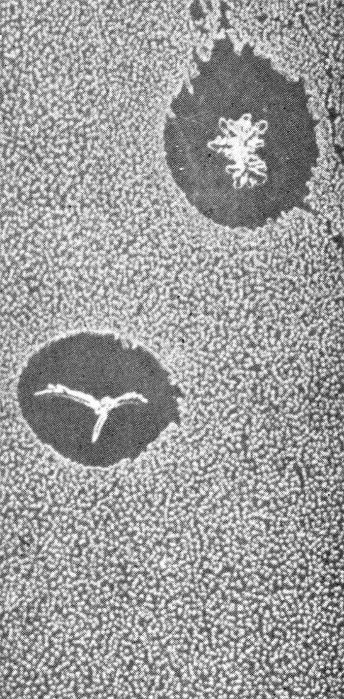
42. Showing in detail granular frost drawing away from true frost crystals

43. Graceful feathers with curling ends
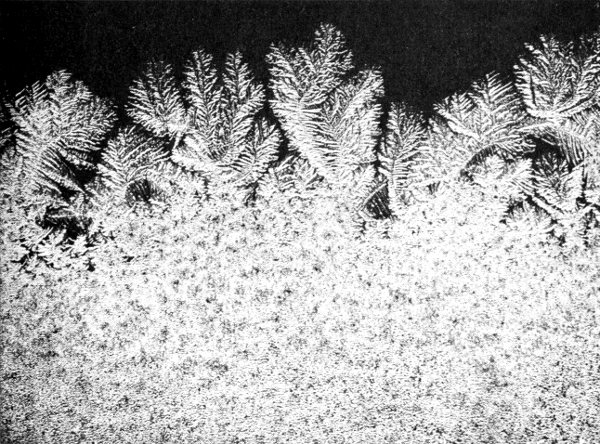
44. Strikingly beautiful example. Evergreen twigs shooting out into clear glass
“When icicles hang by the wall,
And Dick the shepherd blows his nail,
And Tom bears logs into the hall,
And milk comes frozen home in pail.”
—Shakespeare.
In zero weather, in mid-winter, when the earth is frozen to a great depth below the surface, when in driving over the unpaved country roads they give forth a hard metallic ring; when the trees are all stripped of their coverings, with the exception of a few forlorn brown leaves, which cling tenaciously to the skeleton branches, which crack and sway in the chilly blasts; then indeed we may be fully assured that nature has utterly succumbed to the advances of the Frost King, and that “Jack Frost” himself has arrived in earnest.
How he tweaks and nips exposed ears and noses, and how they tingle and ache because of his stinging caress. Jack Frost, we read, is “the very personification of frost and cold.” All of us are more or less familiar with the mischievous pranks of Jack Frost, and they are quite separate and apart from those of the gentle white hoar frost, which is frequently seen early in autumn, upon the first still, cool mornings.
“Jack Frost,” as the great Frost Spirit is familiarly known the world over, is a most important, if rather mythical personage, and very few of us are really familiar with the works which he creates in his more serious moods, and the really wonderful methods which he displays. For, with all his mischief-making, he finds abundant opportunity to work out and display much really fine artistic ability in his choice etchings and decorative schemes.

45. One of Jack Frost’s masterpieces

46. A mass of feathers scattered upon glass
The night time seems to be most favourable for the finest efforts of Jack Frost; usually in mid-winter or early spring. He prefers to select a still, cold night, zero weather, for his best out-of-door display, but it is usually in the coldest winter weather that he applies his very choicest designs upon the glass of our windows, and just how charming and interesting they are, you may judge by the photographed designs herein shown.
Upon a still moonlit night, when Jack Frost is astir, if you chance to be out of doors, especially in the open country, you will be made aware of his presence in many ways besides the tingling of your ears. Suddenly a sharp mysterious report will occur in the forest, and a great tree trunk is cleft mysteriously in twain. Again an ominous cracking, as loud as a rifle report comes from the still ice-covered pond. It is merely Jack Frost indulging in a bit of rifle-practice.
That barren field, brown and unattractive by daylight, how it glistens and scintillates as the moonlight floods it. All last summer’s withered seed pods and grasses; the fluffed-out goldenrod, and many others are rejuvenated and hung with sparkling, pendent ropes of jewels, all the creation and work of the Frost Spirit, who has simply paused to caress them with his icy breath, in passing, and lo, they are beautiful. Later, when the morning sun touches them, they all, like Cinderella, are shorn of their finery, and become as before, just mere commonplace, brown and withered seed pods again. But with infinite patience, as soon as it is twilight the following night, the Frost Spirit steals forth again and restores once more his magic, fantastic pictures by the rays of the wintry moonlight.

47. Sometimes Jack Frost sketches oak leaves
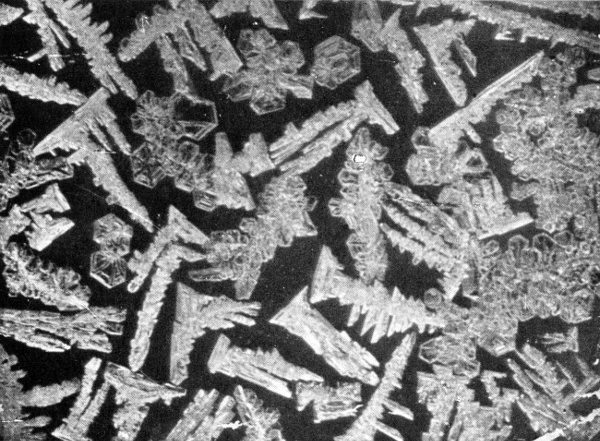
48. Detail of frost crystals largely magnified
The heavy frosts are a recognised and most important factor in creating remarkable changes in rocky formations of the earth’s surface. Large masses of rock are constantly being split and reconstructed by its mighty blasting powers, and great sections of solid material are converted in the same manner into soil by the secret action of the frost, which works continually with the other elements of heat and water to effect these changes. These powerful agents working year after year cause vast and important changes to occur in the formation of mountains and valleys. So great is the power of frost, that it has frequently been utilised in blasting; when water being poured into the crevice of a great rock, and allowed to freeze, the rock was readily split, as desired.
All vegetation succumbs readily to the withering blight of the frost with the exception of the evergreen varieties. The cause for this is, that the juices of plants naturally expand when touched by the frost, and at last burst, which destroys the vesicles or life of the plant, which soon blackens and dies. Of all the pranks in which Jack Frost indulges, his wholesale destruction of the beautiful flowers and plants is the greatest to be deplored. But with all the marvellous works of the mighty Frost Spirit, nothing is quite so fascinating and interesting as the curious phenomena or frost formations which he creates and deposits upon the window-panes in mid-winter. Jack Frost is a finished artist, I assure you, and his etchings are dainty and attractive beyond words.
If you have entered an unlighted room, and seen the moonlight filtering palely through a frost-etched window; then you know its charm. How it glittered and sparkled, the delicate frostwork. You were attracted no doubt and marvelled at the dainty tracings, but few of us have really had an opportunity to study the detail of these frost designs minutely, or have considered that there were more than three or four designs at most.

49. Twigs and leaves
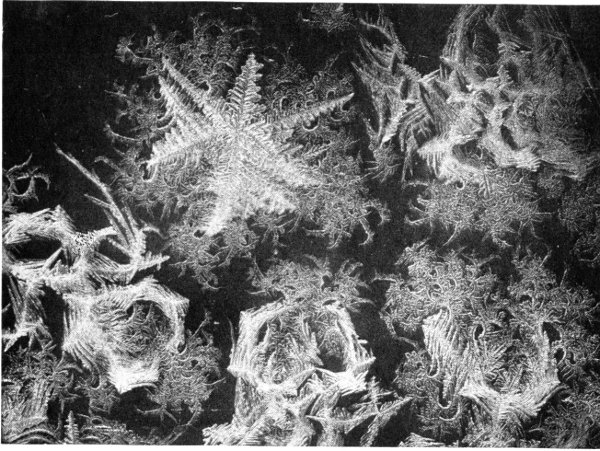
50. Branch-like arrangement of twigs and delicate fern-like leaves
It is only quite recently, in fact, that the beautiful etchings of Jack Frost have been classified and photographed in all their perfection. Happily this has now been accomplished, by the aid of a compound photographic camera, and it opens up a new and fascinating field to the camera expert as well as to the student of frost crystals. Marvellous indeed is the variety and detail displayed in these attractive window-pane etchings furnished by the Frost Spirit, and if one is housed some day, in mid-winter, zero weather, one may watch the entire growth and development of these exquisite frost etchings from start to finish.
To do this, place a lamp or candle before a frost-covered window, in a cold room, or unheated by furnace, of course not near enough to the glass to crack it, but just close enough to melt the heavy frost curtain which may have formed previously upon the glass. After this has been allowed to dissolve gradually, you will observe a thin water film or formation which has been left upon the outer edge of the glass, the centre of which will be clear. Do not disturb this film, for it is in part from this that the frost crystallisations form and develop.
As soon as you move the lamp away from the glass, the pictures instantly begin to grow and develop. Delicate, feathery etchings of ice crystals first appearing around the outer edge of the water film, and according to the temperature of the room, form rapidly or slowly. Exquisite tracings, and fern-like leaves shoot out as by magic toward the centre of the glass, but as soon as they reach a dry place upon the glass, they instantly cease. If you observe very closely, you will discover that meanwhile, in the little open spaces, between the bolder fern-like designs, more delicate feathery forms are gradually appearing, formations which sometimes resemble fine coral branches. As soon as the water-film ice crystallisations are completed they are closely followed by the true frost crystals, which form upon the various dry places upon the glass, delicate lines and stars and also in a thin, dew-like deposit, which rapidly freezes, and assumes a granular, snow-like form. This granular frost develops very rapidly, and soon covers all the unoccupied, clear, dry places; but one curious fact worthy of observation: it does not intrude upon, or approach near to the separate and individual designs or masterpieces, of the frost already formed upon the glass, but rather draws away from their immediate vicinity. This strange habit of the granular frost is well shown in the photographed illustration, where it will be observed that the granular frost acts merely as a background or sky effect for the real frost pictures, as in a painting.

51. Moss-like arrangement of frost

52. Twin freaks
Classified, there are about ten distinct types of the window-pane frost. Representatives of each and all types never appear at any given time upon one window; and strangely enough the designs are never precisely alike on any two panes of glass. Reduplications of any previous design are extremely rare, and would only occur when a multitude of identical conditions occur.
This is rather singular, when we consider the different factors which go to form the window-pane frost. Certain panes of glass vary in thickness and in surface topography, also in the arrangement of minute, invisible scratches, and the accumulation of dust particles which collect from day to day, all of which affect the arrangement and collection of the frost crystals. It has been observed that double windows and furnace-heated apartments are not favourable to frost formations; but in rooms which are allowed to cool off at night, and in rural dwelling houses which are not heated by steam or furnace the Frost Spirit loves to work, and decorates their windows with his choicest etchings.

53. An unusual design
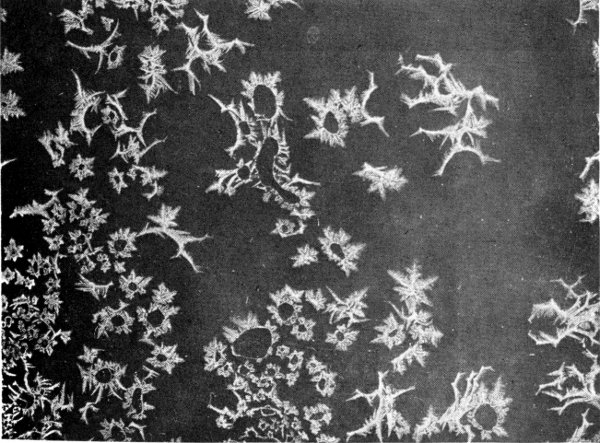
54. A powdering of small flowers
The beautiful frost studies illustrating this chapter were photographed in northern Vermont, where the winters are long and the cold very intense; affording the very best opportunities possible for the development and study of the frost etchings. These studies are, of course, somewhat magnified, yet you will have no difficulty in recognising many familiar frost designs.
No. 35 is a linear type, and of rather common occurrence, easily recognisable.
In No. 36 the photographer scratched his initials crudely upon the window-pane; instantly Jack Frost began to elaborate the crude work, with much better effect.
No. 37 is easily suggestive of a strip of very costly hand-made lace.
No. 38 is a very beautiful arrangement showing two distinct types of window-pane frost. Observe how each type never intrudes upon another. The white fern-like type is raised from the glass, and was formed in a very cold room where it slowly developed and grew for days.
No. 39 is another striking arrangement of the two types; observe the very delicate fleecy patterns of the frost which forms a background for the fern-like scrolls.
No. 40 shows a perfectly developed fern; while in No. 41 we have a strikingly beautiful example of a group of ferns; this type is heavily laid upon the glass, and develops in zero weather.
No. 42 shows very clearly, in detail, the granular formation of the frost which has drawn away from the true frost crystals forming in detached places, in order to give them room to complete their elaborate patterns.
No. 43 shows an extremely graceful feather effect, with beautifully curved scroll like tips.
No. 44 is a very striking arrangement of window frost, showing exquisitely arranged branches, resembling evergreens, shooting out into the clear spaces upon the glass.

55. A maple leaf etching
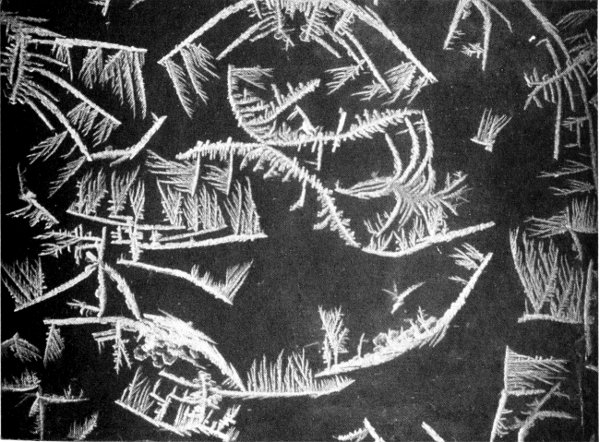
56. Find the frost spider
No. 45. One of the most beautiful and striking masterpieces of Jack Frost.
No. 46. Singularly suggestive of a mass of white feathers thrown loosely upon the glass.
No. 47. Another masterpiece from the brush of the Frost Spirit, a perfect oak-leaf design.
No. 48. This is a largely magnified specimen of window-pane frost, showing examples of frost crystals greatly magnified and in detail.
No. 49. Another arrangement of leaves, showing also branch-like twigs.
No. 50. A very delicate pattern. Note the perfectly formed leaf design with its delicate background of feathery tendrils.
No. 51. A remarkably fine feathery design.
No. 52. Two very freakish specimens of frost etchings. Suggesting somewhat the artificial “flies” used by fishermen.
No. 53. Like a delicate bit of seaweed.
No. 54. Like a delicate powdering of small flowers, scattered over the window-pane.
No. 55. Perfectly formed leaf designs.
No. 56. A design worthy of study. Find the spider.
No. 57. Two types. Suggesting gray moss clinging to rocks.
No. 58. A very rare design. An almost perfect spider’s web, formed of thick, granular frost, with beautiful moss-like ornamentation in lighter design.
No. 59. One of the choicest and most delicate designs photographed which might have formed in the ocean instead of upon a window-pane. No. 60: this beautiful etching was made in northern Vermont, and is very like a white forest of fir trees.

57. Two distinct types of window pane frost
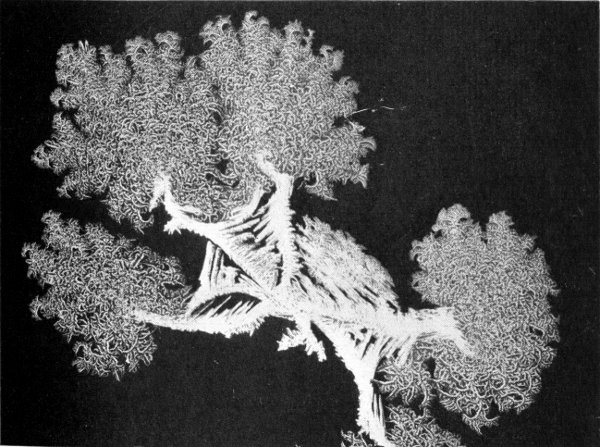
58. Curious design suggesting spider web, with moss-like ornamentation

59. One of the choicest designs of window frost. A perfect specimen of a certain type of delicate seaweed

60. A design of frost work from “the land of the pointed firs”
“Hast thou entered into the treasures of the snow?
Or hast thou seen the treasures of the hail?”
—Job 38:22.
Most of us have given little time or very serious thought to the study of the snow, and the marvellous detail which goes to fashion the individual snow crystal. In fact, if we live in a crowded city, we are inclined to look upon a heavy snowfall as something of a nuisance, to be shovelled and carted away as expeditiously as may be by the army of men employed by the city for that purpose. There it lies, soiled and unlovely, impeding pedestrianism and traffic, and thoroughly undesirable until it is cleared away.
But once outside in the open country we are inclined to gaze forth upon the pure expanse of snow-covered hill and plain, resplendent and dazzling as it stretches afar under the pale winter sunshine, with a more kindly, tolerant mood; for there we may view the snow in all its unsullied charm; and it will surely bring fine sleighing, we concede, and the children are hilarious and happy over prospective snow sports.
But I wish to give you a brief glimpse into a realm of snow which is filled with charm and mystery, and when you have looked into that realm and studied for yourself the marvellous phenomena and detail of snow-crystal formation, you will doubtless ever after, when gazing forth upon a snow-covered expanse, or in watching the fluttering, swirling flakes as they descend, exclaim: Oh, the wonder and mystery of it all! How can it be possible for such exquisitely beautiful jewelled crystals to fashion themselves in the vast spaces of the heavens, among the clouds!
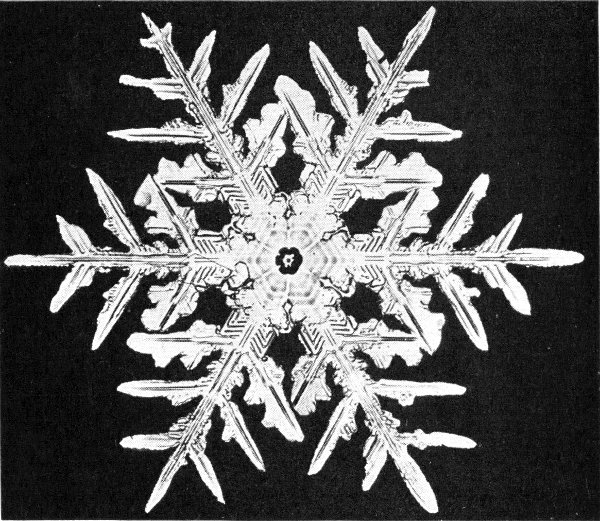
61. Blizzard type
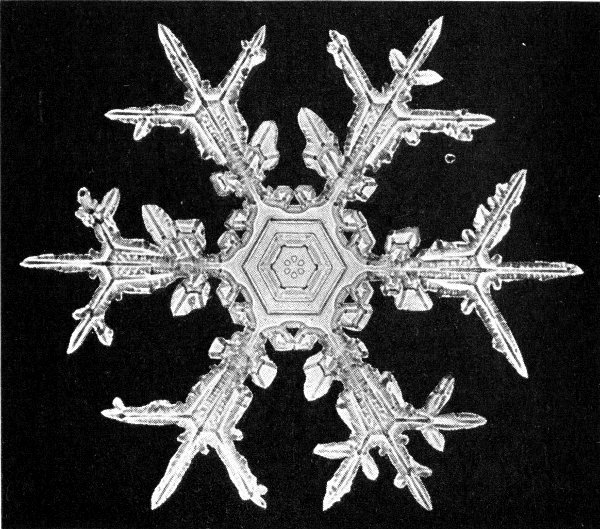
62. Exquisite jewelled type
Snow is, in itself, the water in solution, crystallised into irregular and regular, more or less geometrical forms and designs, of which there are two distinct types; the crystalline and the granular forms. The granular formations embody a special type, and the crystalline formations are usually transparent or ice-like, and vary in size greatly, some being about three-quarters of an inch in greater diameter. They fall either singly or bunched together, according to whether the temperature and humidity is high or low.
The structural formation of snow crystals is generally found to be of hexagonal shape, usually six-cornered or pointed, although rare types have been discovered and photographed where such was not the case, as the trigonal crystals shown. Snow crystals have been classified, as to structural formation, into two types; the tubular and columnar. The columnar types are formed of long, slender, needle-like crystals or columns, usually tapering at one end, while the tubular crystals are developed upon an extremely thin tubular plane. Frequently we find that two types have united, thus forming the “compound” crystal, which is rare, and frequently a very beautiful, showy snow jewel.
The tubular crystals are of more common occurrence and exhibit greater beauty and diversity of outline than the plain columnar types.
The internal formation and design of the snow crystal is of great importance and interest, and the delicately etched markings which occur upon their surfaces, and are so well brought out in the photo-micrographic illustrations, are due to certain minute air inclusions or small air tubes. When the light falls upon the crystal, these air tubes appear as dark tracings or lines and shadings and go to form and carry out the design of each individual crystal.

63. Solid, big storm type
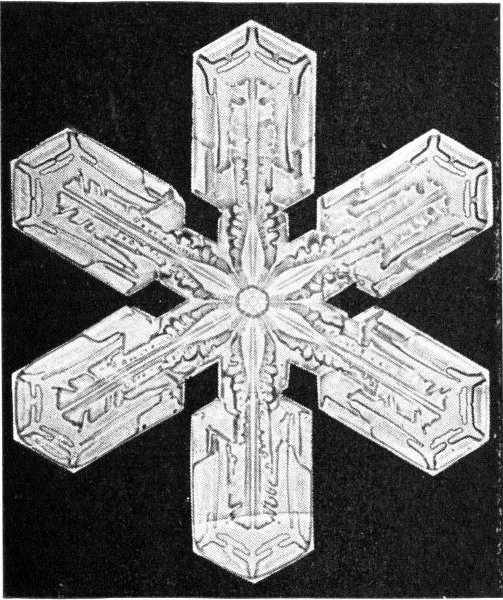
64. A very symmetrical crystal

65. High altitude crystal
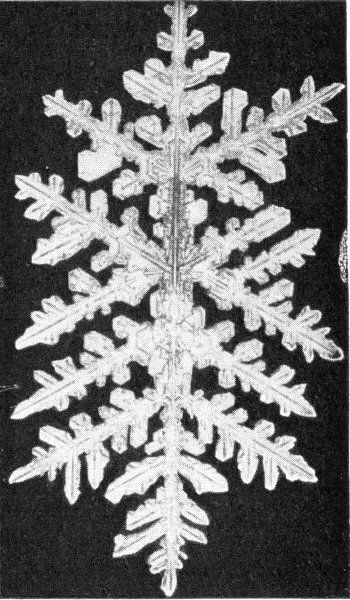
66. Freak crystal formed by broken sections uniting
During great snowstorms the winds within such storms blowing spirally inward toward the storm centre near the earth, and at the same time upward and outward, above, exert the vast powers of bringing together the material, the water vapours, which in conjunction with the icy breath of the raging blizzard, perfects the formation of the snow crystal.
Far above the clouds, in the vast silences of space, in thinnest air, supported solely by up-rushing winds, the little snow crystals form and multiply, embellished and enlarged by their continual warring contact with the elements, until at last they descend earthward.
Many of these beautiful crystals are doubtless great travellers, for they are frequently, when first generated in space, exceedingly light in formation, so much so that not until they have been buffeted about repeatedly by the Storm King, do they gain sufficiently in structure and in weight to descend. They are gradually built up and become heavier by the varying conditions of air pressure, degrees of humidity, aided also by electric currents.
Often the delicate crystals are handled so very roughly while passing from cloud to cloud strata, and violent choppy winds, that there are frequent collisions and many of the crystals reach us in a broken, imperfect state. Perfect crystals are by no means common, and it requires infinite patience and skill to capture and photograph them in perfection. During a great blizzard or snow-storm, lasting for days, which one might reasonably hope would be quite prolific of many perfect specimens, perhaps only one or two really perfect or noteworthy crystals may be obtained.
It is only within the past few years that scientists have been enabled to secure crystallographs with any degree of success, so that all early observers of snow-crystal formation were compelled to rely upon the magnifying glass for all information regarding their delicate formation, and crude drawings were made from such observation and served to illustrate articles upon the subject, as shown in the early writings of Tyndall and others.

68. Air inclusions unusually clear
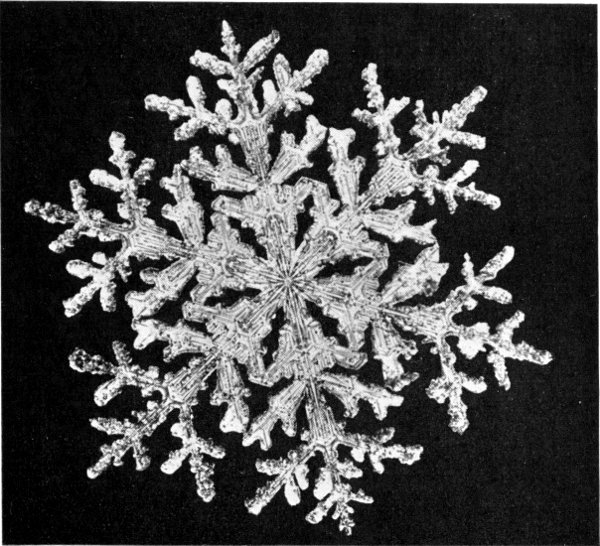
69. Low altitude type
It is to Mr. Wilson A. Bentley who is recognised as the pioneer in crystal photography, that I am indebted for the wonderfully beautiful illustrations shown, and which have been selected with much care, in order to give as clearly as possible some idea of the many distinct types and the formation of crystals produced during given types of storms or blizzards. Mr. Bentley has during his many years of valuable work for the Government along these lines, secured thirteen hundred distinct snow crystals. Strangely enough, in all that time, he has never run across duplicates. Nature, it seems, is ever versatile and the rarity of her patterns is practically inexhaustible.
Unlike the mineral crystals, or those found in the mineral kingdom, which form beneath the surface of the earth, and are dependent largely upon their surroundings and environments for their crystalline formation, the snow crystal is most ethereal; born in the vast spaces of the heavens, fashioned by the changing clouds and vapours, its lullaby the hoarse crooning of the mighty blizzard, the little snowflake is tossed to and fro, now borne to earth for a brief time, only to be caught upward and tempest-tossed into space again. Perhaps this process occurs many times, for the snowflake is a mere plaything of the storm, until at last the capricious winds permit the snowflake to descend. Timidly and gently it is at last allowed to fall, seeking a final resting place upon the broad bosom of Mother Earth.
It is thus that the snow crystal grows and matures, owing its crystalline formation entirely to the constant tossing and warring with the mighty forces of the storm, and the buffeting which it encounters upon its long journey earthwards.
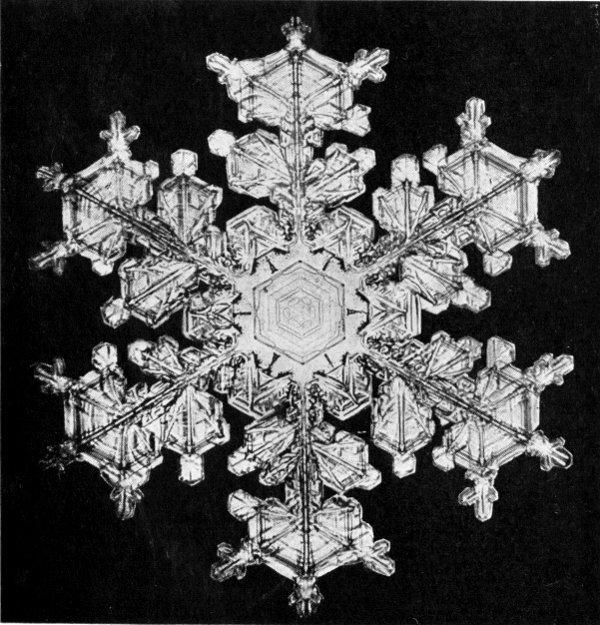
70. Local storm crystal
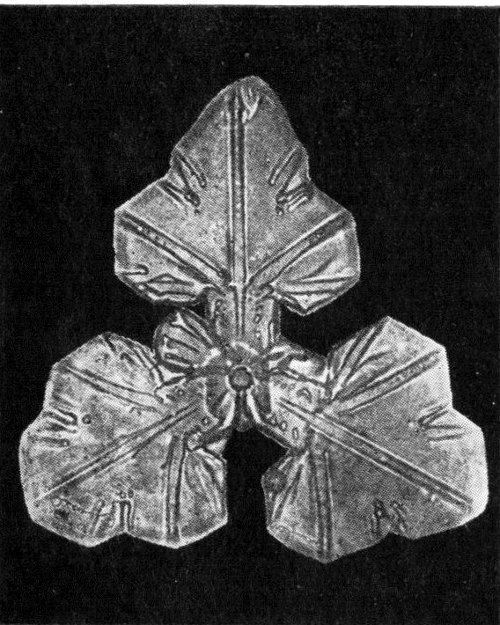
71. Freak trigonal crystal
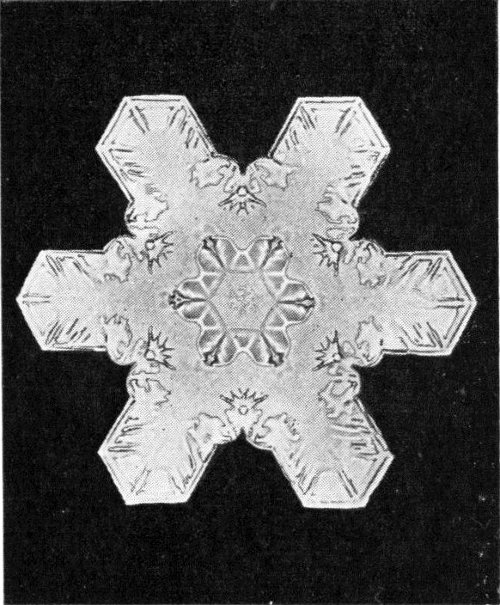
72. Elaborately etched
“When e’er a snowflake leaves the sky
It turns and turns, to say good-bye.
Good-bye, dear clouds, so cool and gray,
Then turns and hastens on its way.
“But when a snowflake finds a tree
Good-day, it says, good-day to thee.
Thou art so bare and lonely, dear,
I’ll rest and find a playmate here.
“But when a snowflake brave and meek
Lights on a little maiden’s cheek,
It starts—how warm and mild the day,
’Tis summer; and it melts away.”
It is of course utterly impossible to bring before you in the photo-micrographs of the snow crystals all their many charms, their exquisite hues and rainbow shadings, as each crystal radiates with prismatic hues which are due greatly to air inclusions and resembles closely at times, clusters of magnificent jewels. We get this effect in mass, if we gaze forth upon a wide expanse of snow illuminated by pale moonlight, or flooded by strong sunshine. The scintillation is almost too dazzling at times for the eyes, and we are duly impressed by the magnitude of snow-crystal formation. Numberless they are, and like the sands of the seashore. We find that in making a collection of snow crystals by photo-micrograph, during a period covering twenty years of study, in which thirteen hundred perfect specimens were found, that the entire number discovered, when massed, would form only about one cubic inch of snow.
How many millions of these exquisitely constructed jewels do we heedlessly crush and shatter unconsciously during a brief walk in the snow and how crude and imperfect seem the productions of human minds and hands when compared to those formed by the blind forces of nature.
The exquisite and varied types of snow crystals herein shown, were photographed in northern Vermont; a locality where the snow-storms are frequently long and severe and where the country by-roads are blocked and impassable for days, while huge drifts pile high above the fences, and often cover the windows.

73. The cuff button crystals. From a great storm
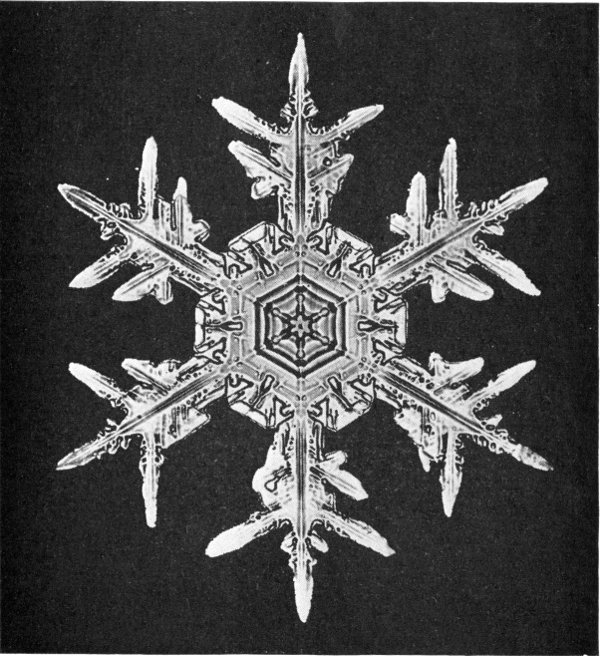
74. Low cloud crystal
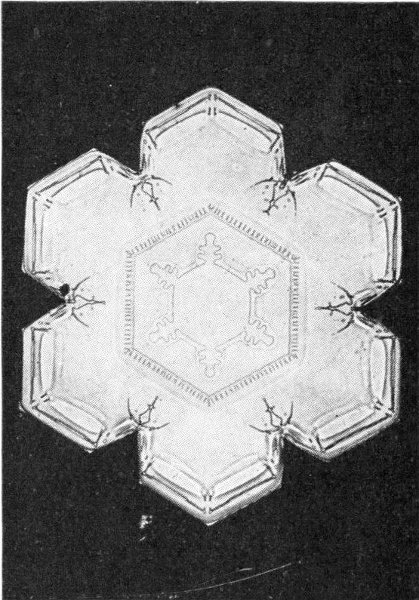
75. A beautifully marked high altitude crystal
Whittier brings before us the whole picture so charmingly in his beautiful “Snow-Bound”:
“Zigzag, wavering to and fro,
Crossed and re-crossed the winged snow;
And ere the early bed-time came
The white drift piled the window pane.”
In these severe winter snow-storms which our New England poets illustrate so aptly, we become familiar with the snow in all its unsullied purity, and if we are New England born, we never forget the white, frozen charms of those rigid winters, no matter where we stray, or how torrid the sunshine of our abiding place in later years.
Many there are among us who are familiar with and love that winter idyl, the wintry landscape—a blended symphony of colouring; warm russet browns, gray, and rich velvety greens. Against the dense greens of the Hemlock and Spruce, the sturdy mottled Sycamore branches, with their little pendent russet balls clinging tenaciously to their topmost twigs, stand forth in bold relief, while graceful white birches, slender and ghost-like, mingle and blend with the sombre gray trunks of Chestnut and Birch, which toss and sway their denuded branches high in the frosty air.
A cold gray sky—then stealing down appear the first silent fluttering snowflakes, floating gently earthward. A brooding silence settles over all, unbroken save perhaps by a straggling flight of crows winging their way heavily to safe shelter among the distant forest of dark pines. Timidly at first descend the first advance heralds of the great storm, the tiny snowflakes; then suddenly ever faster and faster they assemble, until the dreary, leaden skies and the landscape picture is confused and merged together in a gray curtain; shut out by the wildly eddying, swirling snow.

76. Crystal coated with granular snow

77. Having flower-like petals
“Announced by all the trumpets of the sky,
Arrives the snow, and driving o’er the fields
Seems nowhere to alight, the whitened air
Hides hills and woods, the river, and the heavens
And veils the farmhouse at the garden’s end.”
Every living thing instinctively seeks safe sanctuary against the advancing fury of the storm; and desolation broods o’er all the land. The hoarse winds rise and rage and croon their wailing symphonies about the picturesque old gray-gabled farmhouses, and the inmates settle themselves contentedly within doors where all is made safe and snug. And thus the mighty blizzard rages for days. But at last the grateful sunshine deigns to burst forth once again, and like magic the scene of desolation has changed:
“Come, see the North Wind’s masonry
Out of an unseen quarry evermore
Furnished with tile, the fierce artificer
Curves the white bastions with projected roof
Round every windward stake, or tree or door.
“Leaves when the sun appears, astonished Art
To mimic in slow structures, stone by stone,
Built in an age, the mad wind’s night-work,
The frolic Architecture of the snow.”
For the trees which tossed their naked gnarled branches in the pitiless wind before the storm have been rejuvenated and clothed anew in soft white velvet draperies, and the old gray fence rails gleam and scintillate, cushioned with snow. It would almost seem as though nature had endeavoured to carry out some special decorative scheme when she draped the evergreens, for see how beautiful are the Southern Pines with their brush-like tufts of needles, each one resembling a snowy pompon of feathers. The graceful, drooping Hackmatack tree looks as though the children had decorated it with strings of popcorn, the tiny cones at intervals each touched with a wisp of white snow carrying out the effect. While the Balsams wave their serrated branches, each tiny needle outlined in white, and the stately Hemlocks bend low their glossy green boughs, flattened and draped heavily with snow. In the hedges the thick underbrush appears for all the world like a field of ripening cotton, each group of twigs supporting a whorl of cotton-like snow. No true New Englander repines or deplores the desolation of such a scene; to him it is not a gloomy spectacle, but rather festive.

78. Very intricate design
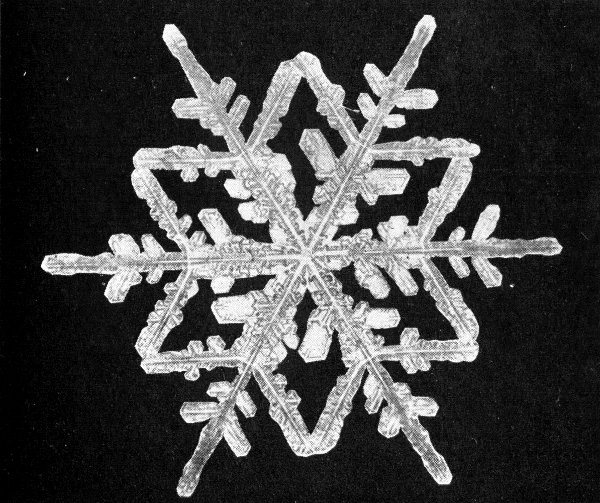
79. Showing a perfect star. Low altitude type
Should you wander alone far afield, perhaps across some hilly pasture where above the soft snow hummocks last year’s drying seed-pods and grasses gleam frost-touched and sparkling in the sunshine, into the edge of the “spruce bush,” if you are a lover of nature in all her moods, aside from the glittering beauties which meet the eye upon every hand, you will be impressed by a wonderful calmness, a brooding silence, which came with the advent of the snow. This silence is so impressive that even the velvety pad of some little furry creature in the underbrush is startling, and the tapping of the brave little woodpecker up aloft sounds stridently keen and obtrusive. It is as though the storm in passing had left as a benediction, this great peace which broods over all.
In tropical countries snow is never seen, for it does not reach the earth, excepting that which falls upon lofty mountain tops. On the summits of very high mountains the snow occurs intermittently whether in frigid or tropical zones. Snow is a wonderfully important factor in the laws which govern irrigation, for as it melts upon the tops of mountains it adds greatly to the watershed or drainage, flowing into all streams and carrying fertility to all regions.

80. Frigid altitude crystal
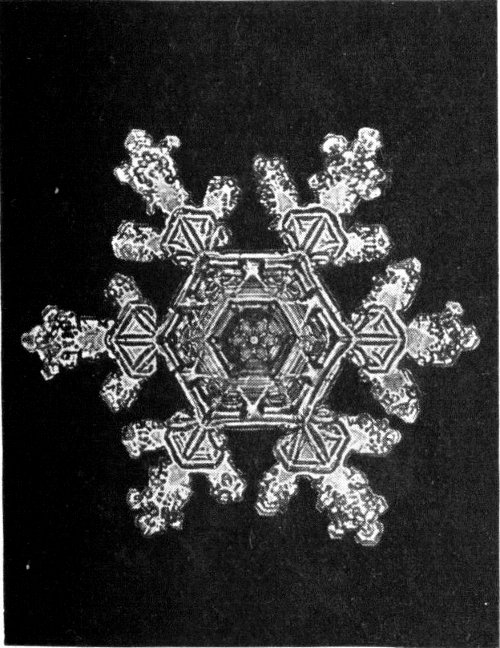
81. High and low altitude combined
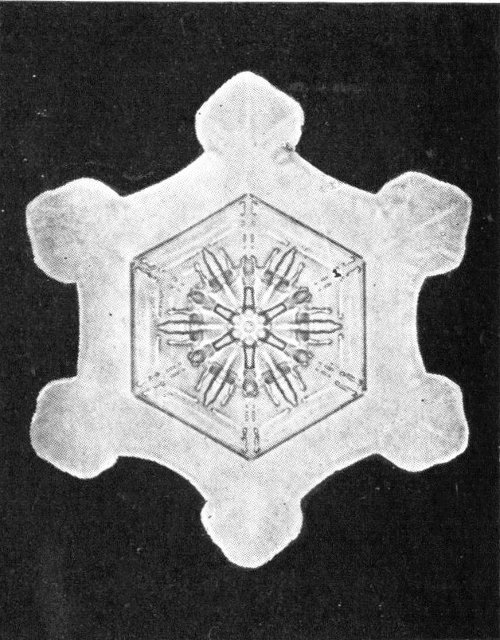
82. Having beautifully etched centre
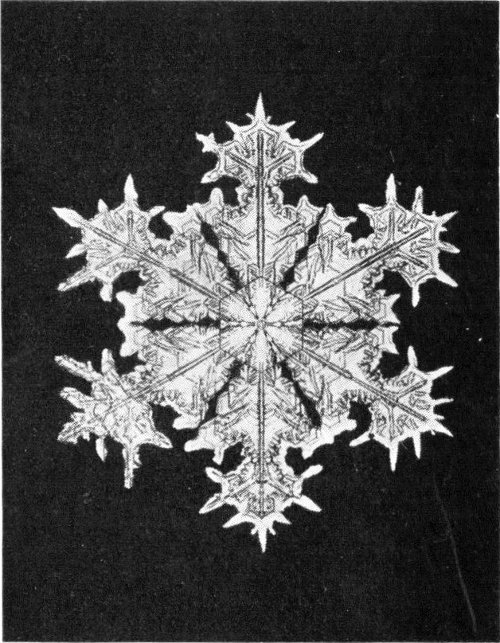
83. A diamond pendant
Although certain types of snow crystals may be detected with the naked eye, most of them are so tiny that their structural form cannot be determined without the aid of a microscope. If you chance to be out of doors during a snowfall, and happen to wear a dark coat of wool material, observe closely the flakes which chance to alight upon your sleeve and perhaps you may be able to recognise a true crystal.
When, as we sometimes remark, “Mother Goose is shaking out her feather bed,” and the white flakes come drifting down in large loose feathery flakes, then we may more readily discover a crystal without the aid of a glass. It is then that we find the lace-like, open, branchy and star-like shapes. These usually form during a local storm, or from a storm preceded by a warm wave. But the hard pellet-like crystals which sting our window-panes in falling, are from a very high altitude, and have been great travellers.
The study of the snow and its many mysterious phases is full of surprise and charm; and its various demonstrations fascinating and almost unexplainable. Among the many strange manifestations encountered in the kingdom of snow, perhaps there is nothing more mysterious than the so-called “snow rollers.” They are rather a recent discovery among snow students, and not frequently encountered. Two good examples of these curious rollers are given in photograph illustrations. The photographer came upon them quite unexpectedly and thought at first that the children had been amusing themselves by rolling huge snowballs. But upon investigation he discovered that these mysterious bundles of snow were quite hollow, like a large muff, and scattered at intervals over a large snow-covered field. These mysterious snow rollers form only after a light fluffy snowfall, followed by a rise in the temperature, from a degree or so above zero up to 36° or 38° above, accompanied by a peculiar stray gusty wind.

84. Clean cut prism-like crystal from high altitude
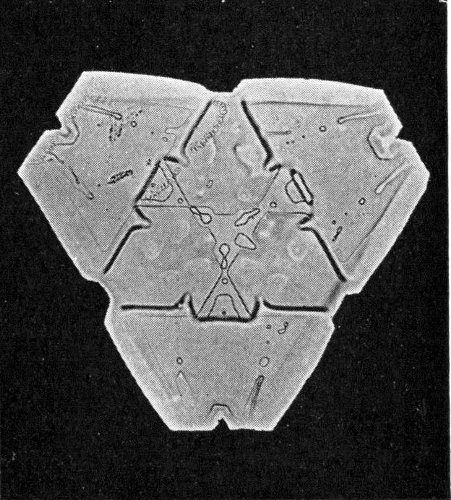
85. Suggesting a Masonic emblem. Trigonal crystal
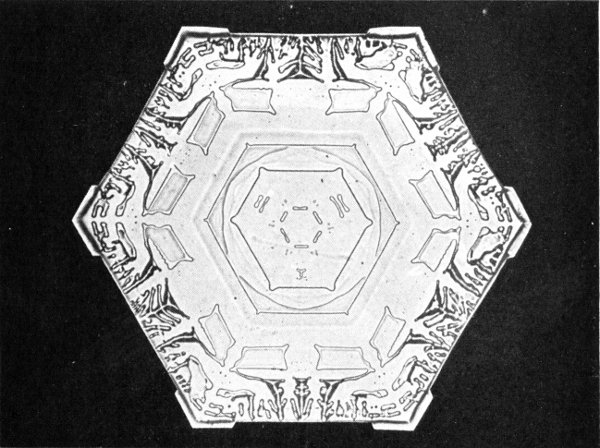
86. The Egyptian crystal, because of its characteristic tracings
The rollers form most frequently in the foothill regions, wherein these gusty winds pour over and around the hilltops, and down across the valleys. After the temperature has reached 36° to 38° above and the snow upon the surface of the ground has been slightly dampened and rendered sticky, the capricious wind gusts scoop up here and there small particles of the moist snow, and overturn them upon that in front, forming a ridge or hollow arch, which is the commencement of the snow roller. Then the wind gets back of it, and proceeds to roll it forward, until, as it gradually rolls along it accumulates more snow, and increases in size, until it becomes too heavy a plaything for the sport of the winds, and then it stops.
These snow rollers grow in size both in diameter and in length, as they roll along, and attain various sizes from a few inches in diameter up to two feet in diameter. Some of the rolls are overturned by the boisterous winds in such a manner as to form a hollow snow arch, and hence some of the rolls are hollow even when matured. Hundreds of these rather mysterious snow formations occur to the acre of land, and they form both on a dead level and upon inclines.
That snow crystal study is extremely fascinating is well shown, for Mr. Bentley declares that although he works out of doors for hours at a time, when often his hands are well-nigh frost-bitten by the intense cold, in below zero weather, yet he is himself almost unconscious of discomfort or real suffering from the cold, so keenly interested and intent is he at the time, in securing some new and wonderful type of crystal to add to his already large collection of snow jewels.
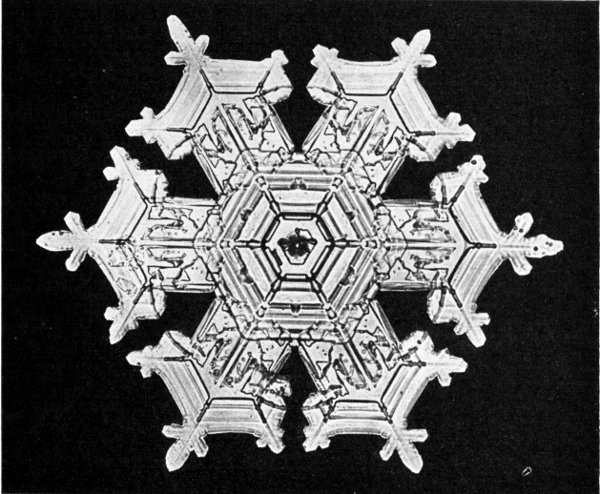
87. Unusually symmetrical and clearly defined

88. Singular detail; dotted centre design

89. Trigonal crystal, very cold storm type
To make a collection of the snow crystals it is necessary, first of all, to make a receiving board. This is just a flat board covered with black velvet or wool material. The operator then places the board in a favourable position for catching the flakes as they descend, and then closely watches the receiving board as flake after flake alights upon the black surface. His eye will become sufficiently trained by experience at last to detect a fairly perfect specimen. If such a crystal alights—and sometimes it is weary waiting, for in a storm lasting an entire day, frequently but two or three perfect crystals deign to alight upon the receiving board—but when the perfect crystal arrives, then with infinite skill, and just the right touch, which must be acquired by practice, the little crystal is gently lifted upon a tiny, sharp-pointed stick, transferred to the slide and photographed as quickly as possible, before it has had an opportunity to dissolve, and become again a mere drop of uninteresting moisture. The camera used is photo-micrographic, or a camera with a microscopic attachment.
Regarding the formation of the snow into crystalline forms, we are told that the molecules and atoms of all substances when allowed freedom of movement, form themselves into many definite shapes and designs called crystals. Minerals, gold, silver, iron, sulphur, when melted and permitted to cool, gradually show this crystallising power. And by dissolving saltpetre in water and allowing the solution to slowly evaporate, large crystals will form, more or less symmetrical, as the salt is converted into vapour. Alum readily crystallises in the same way. The diamond is crystallised carbon, and all precious stones are examples of mineral crystals. It would be quite an interesting and novel experiment to photograph some of these crystals formed of minerals such as saltpetre, alum and others, and to compare them with the structural formation of snow crystals.

90. Note the young germ crystals invading this crystal
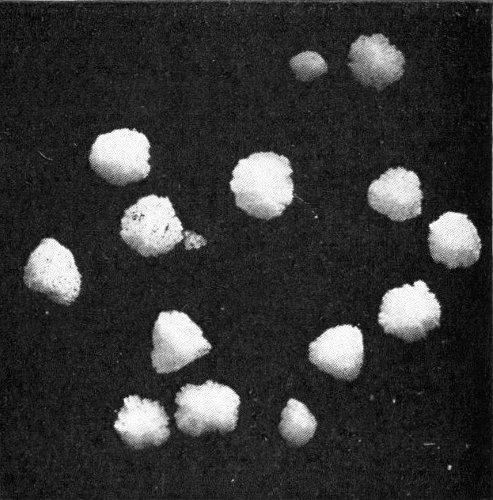
91. Granular pellet crystals from a warm cloud
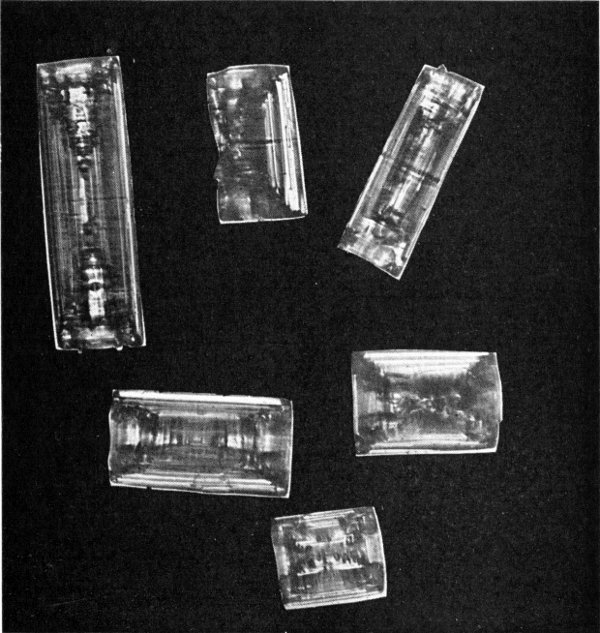
92. Columnar six-sided type. Singular effect of miniature photographs enclosed
Water itself as a liquid is to all appearances formless; when sufficiently cooled, however, the molecules are brought within play of the crystallising force, and thus arrange themselves in more or less attractive crystals. A most interesting point, well worthy of consideration, is that it is extremely improbable that anyone has as yet found, perhaps never will find, the one preëminently beautiful and symmetrical snow crystal which nature has probably fashioned in her most artistic mood—her masterpiece. The study of this unique branch of nature work is as yet in its infancy. It possesses all the charm of novelty, and many who take it up will find in it a source of much pleasure as well as instruction.
It would seem that there is really no limit to the number of distinct forms and types among the snow crystals. It will be noted that many of the designs are most rare and fanciful, and really worthy of developing and reproducing in many ways. The open, lace-like types might well be copied by a jeweller or worker in precious stones, for nothing could be more exquisite in a pendant or brooch than one of these snow-crystal designs carried out in diamonds. Others suggest rare patterns for lace work and embroideries, while others are wonderfully effective pieces of mosaic work, or suggestive studies for stained window-glass. Many of the patterns might well serve for wall-paper or print material designs. And as a drawing lesson, the simpler forms might be copied and with their history and detail, afford a pleasant and profitable study.
Ideas along these lines it seems to me are limitless and well worth cultivating.
Again, to quote Whittier, how charmingly has he portrayed, in the following lines, the strangely beautiful and mysterious formation of the ethereal snow crystal:
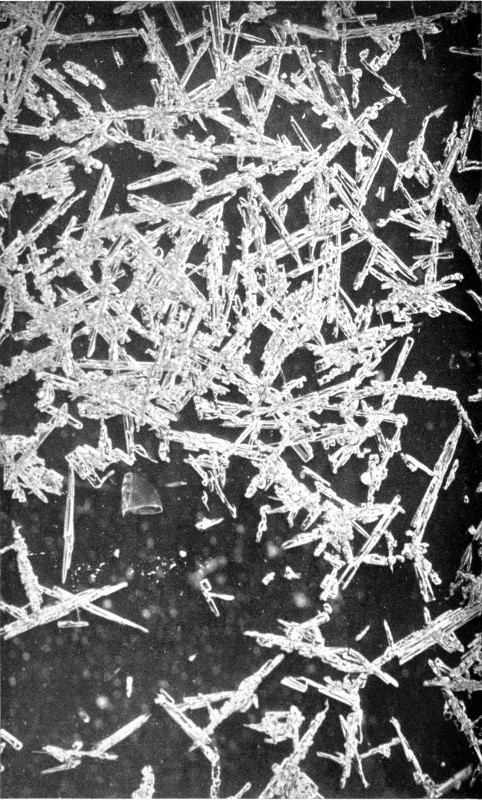
93. Sleet, sharp and stinging
“So all night long the storm roared on;
The morning broke without the sun;
In tiny spherule traced with lines
Of Nature’s geometric signs,
In starry flake, and pellicle,
All day the hoary meteors fell.”
That all may know and understand the life history and formation of the crystals shown in the photographs, I will give a brief description of each which you will doubtless find both interesting and instructive. It will be seen that each crystal possesses some individual characteristic differing entirely from its predecessor, and each, in its way, fascinating and beautiful.
No. 61. A very showy crystal, of local-storm type, also a blizzard crystal formed in low, warm altitude.
No. 62. This exquisite crystal might well suggest a jewelled brooch or pendant of rare workmanship. It began its formation in a very high altitude, where the solid, hexagonal centre was formed, started to descend in plain hexagonal form, but was caught upwards by the rushing clouds, tossed about awhile, and then allowed to pass into a lower, warmer altitude where its elaborated branches were added.
No. 63. A high, frigid-altitude crystal, notable for its delicately traced centre design, and the six curious, apparently raised formations in the plainer spaces.
No. 64. Remarkable for its six beautiful prism-like rays, and central wheel-like structure.
No. 65. An exquisitely designed centre, with air inclusions strongly marked.
No. 66. This crystal has been formed of two sections, and must have encountered another broken crystal in its travels, with which it united, and from this its crystalline growth formed.
No. 68. An oddity. The air inclusions are very strongly marked and bring into sharp relief its rare central design.
No. 69. A local-storm type. These crystals are always loose and feathery in construction.
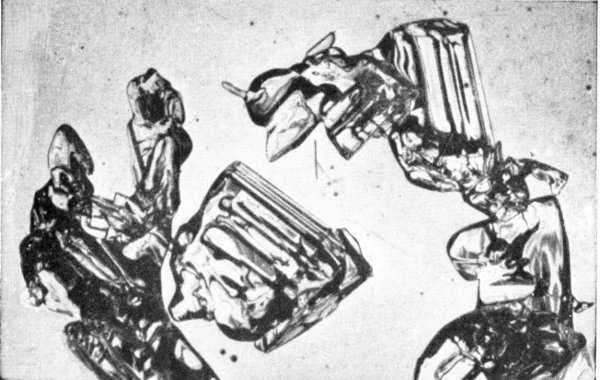
94. Old snow, re-crystallized
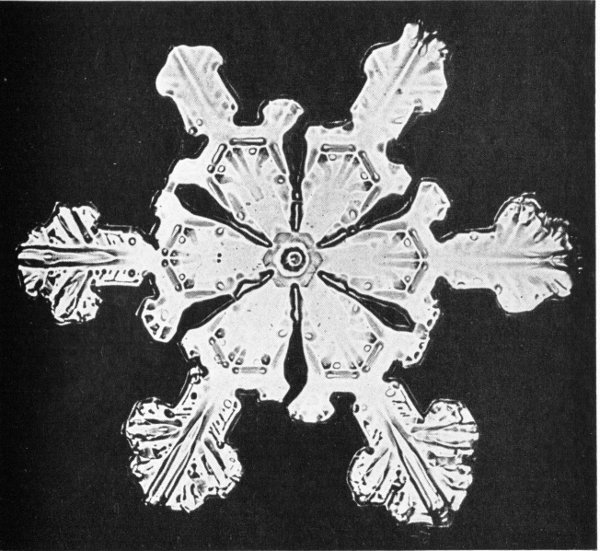
95. Freak crystal. Developed the sides only which fell downwards
No. 70 was started in a very high, cold altitude, and completed in warmer clouds.
No. 71. A rare trigonal form, a sort of “freak” crystal.
No. 72 has delicate tracings.
No. 73. A very remarkable group of snow crystals, which always attract wonder and incredulity, as they appear upon close inspection to represent quite a pretty set of collar buttons or studs. These snow crystals are the product of a very great storm, and they travelled a long distance before reaching the earth. They were generated in a very high, frigid altitude. When these singular snow crystals descended they fell in parachute fashion, the larger section downward.
No. 74. Low-altitude type.
No. 75. This crystal is remarkable for the peculiar delicately etched tracings of its centre, and the rather curious designs in each scallop. A rarity.
No. 76. A crystal powdered with frost-work; has granular edges.
No. 77. A flower type, having few air inclusions, as it grew rapidly and continuously.
No. 78. A very beautiful jewelled design of the diamond pendant type. A local storm crystal.
No. 79. Also a local-storm crystal, generated in warm, low clouds.
No. 80. A perfect hexagonal type having rarely beautiful air inclusions.
No. 81. A lace-like crystal.
No. 82. Note the very beautiful centre elaboration of this crystal, and the plain, apparently unfinished branches.
No. 83. An extremely showy crystal; also a blizzard type.
No. 84. A singularly beautiful type, having unique centre elaborations, and perfect, glass-like prismatic branches.
No. 85. Here we have what appears at first glance to be some secret emblem or Masonic order sent from cloud-land. Of rare trigonal, solid form.

96. Snow rollers. Very rare
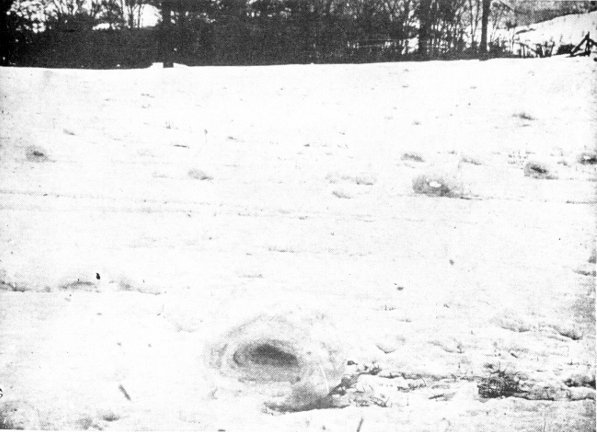
97. Scattered like huge muffs over large tracts of land they lie
No. 86. An Egyptian mystery. Study the markings of this strange crystal closely; its delicately etched centre formation, and the strange characters which form its border. May it not well be some secret cypher message from the skies? Who shall say? This crystal is an extremely cold weather type, as all solidly formed crystals are.
No. 87. The peculiarity of this crystal is the apparent correction made in its nuclear construction.
No. 88. A very delicate and beautiful type. Note the strange grouping of symmetrically arranged dots in its centre formation.
No. 89. Trigonal. A general-storm type.
No. 90. Upon the face of this crystal appear young germ crystals which have attached themselves to the crystal proper.
No. 91. Round, granular snow pellets, from cumulus clouds.
No. 92. Columnar snow crystals; a peculiarity noticeable in these ice-like prisms is that each one contains apparently, at first glance, a picture held in its depths.
No. 93. This is another distinct type of snow, the needle, or spicular form—sleety, which stings and cuts the face when driven by high winds.
No. 94. A piece of old snow re-crystallised.
No. 95. This crystal is remarkable in that it fell and grew heavier side downward, leaving its upper branches undeveloped.
Nos. 96 and 97 show the mysterious “snow rollers” scattered over the surface of a field, with a glimpse of the wintery landscape as a background.
Nos. 98, 99, and 100 are “freak” crystals, 100 showing singularly shaped tablets attached.
No. 101. A twin crystal.
No. 102. This crystal grew very rapidly and continuously; a warm cloud type.
No. 103. Two types combined.
No. 104. A rare design, with fluted prisms, central etchings notable.

98. A freak crystal

99. Two broken crystals united
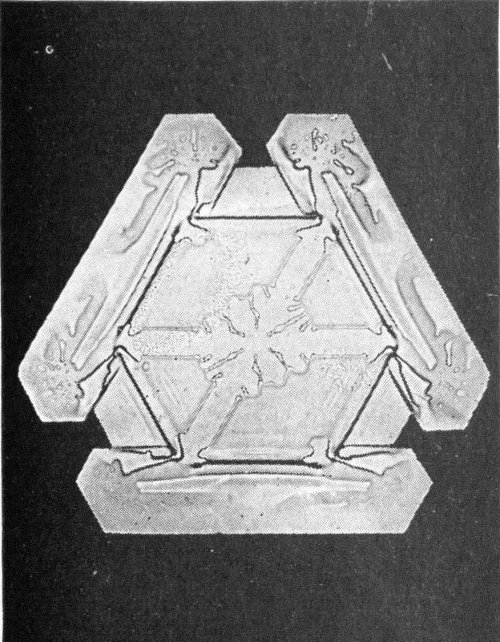
100. A society emblem. High altitude
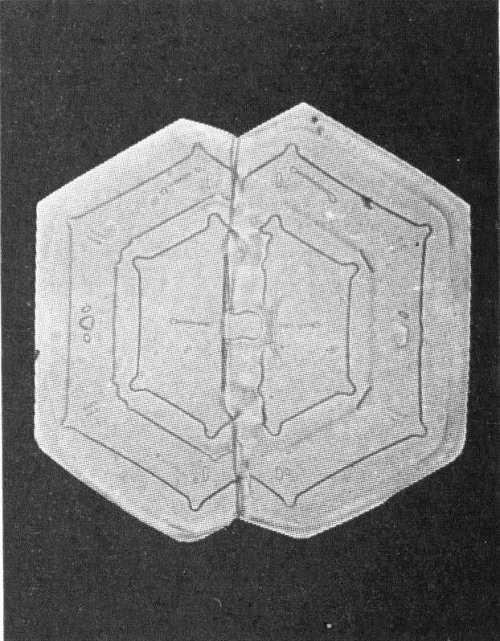
101. Twin crystal
No. 105. A remarkably fine specimen. A cold-weather type of crystal. Also has marked perfection in air inclusions.
No. 106. This crystal is another great traveller, a high-altitude type. Such crystals usually possess marked precision and finish in detail as they are long in forming.
No. 107. A star crystal.
No. 108. Notable for its very dark centre, and scroll-like detail.
No. 109. Plain, high altitude type.
No. 110. Local storm type.
No. 111. A prismatic beauty.
No. 112. A very frigid-altitude type.
No. 113. Contrasting, low-altitude type.
No. 114. This crystal possesses a remarkably intricate and noteworthy centre.
No. 115. Also has elaborate centre design.
No. 116. A remarkably beautiful, jewelled effect; intricate centre. This crystal is another mystery. It is of a high-altitude type, and is called “the arrow crystal” because of the six clearly defined arrows upon its surface. A crystal worthy of study.
No. 117. Remarkable feathery type. Low-altitude crystal.
No. 118. Notable for very dark centre, and invasion of germ crystals upon its surface.
No. 119 shows a high-altitude type where the centre hexagonal portion is well perfected, but the branch-like rays show imperfections and incompleteness of structural formation.
No. 120 is one of the most showy crystals in the collection. Of trigonal formation with fantastic prism-like branches; a high-altitude type.
No. 121 is a strange crystal, something of a “freak,” while No. 122 is a singularly beautiful type, notable for its very dark centre, and the unique and rather mysterious tracings which go to form its border. This crystal must have remained in a very high altitude for some time before descending as it shows finely finished detail.

102. A feathery type. Local storm
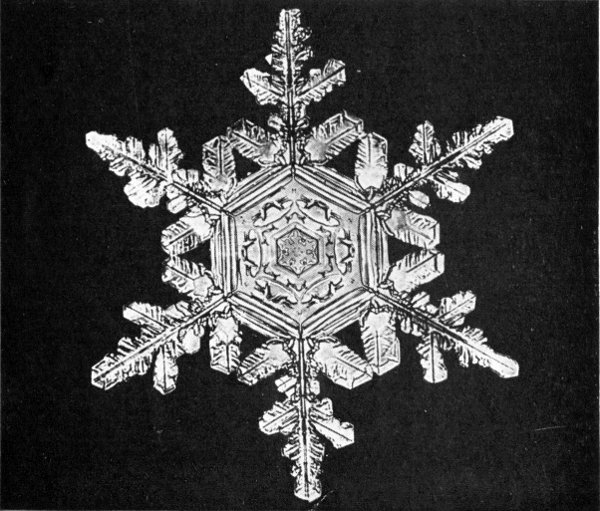
103. Leaf-like terminations
No. 123 is a beautiful flower type. Usually the branches merge together but in this instance they remained open like flower petals.
No. 124. A high-altitude crystal covered with a deposit of granular snow.
No. 125. Very high-altitude type, having curious inner tracings.
No. 126. A beautiful symmetrical star design, with leaf-like terminating branches. A local-storm type.
No. 127. A great traveller from a cold high altitude.

104. Delicately etched centre

105. High altitude crystal. Rare and singularly perfect in construction
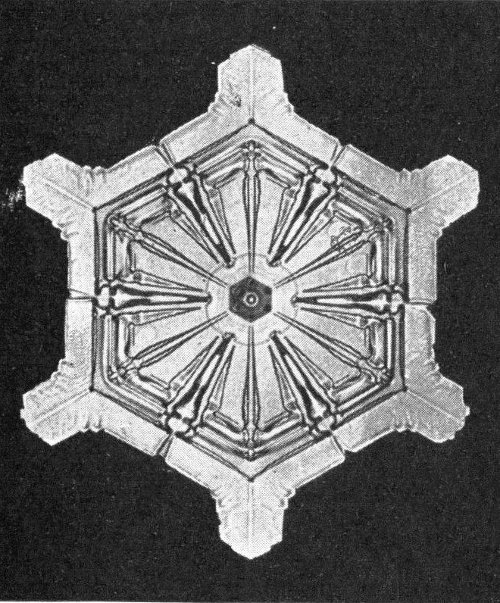
106. Solid type
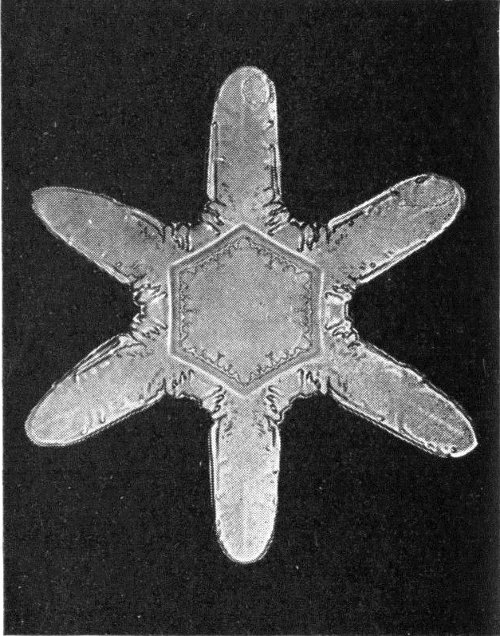
107. A star type. Very high altitude
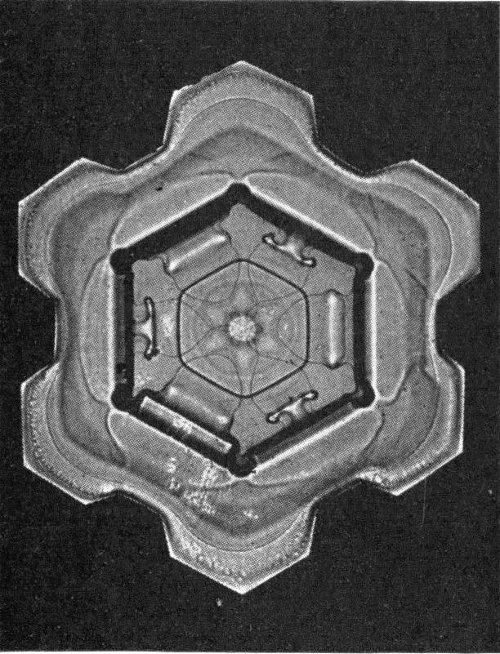
108. Very unusual centre formation

109. Mosaic like
“Down swept the chill wind from the mountain peak
From the snow five thousand summers old;
On open wold and hilltop bleak, it gathered all the cold—
The little brook heard it and built a roof
’Neath which he could house him, winter-proof.”
When in mid-winter, pond, lake, and river are covered with a glittering icy coat of mail, when the rushing babble of the little brook sounds strangely muffled and restrained because of its icy fetters, then we know that all nature is once more in the stern, iron grasp of winter, which brings with its piercing icy breath, great discomfort, as well as charm and exhilaration to all.
For who has not at some time in their lives revelled in the wonderful, joyous pleasures of skating? The ice crystal-clear beneath our polished steel, as we glided bird-like, swiftly over the polished, mirror-like pond beneath us. What exhilaration and glow we found in the fascinating sport. But how seldom, if ever, did we give a thought to the wonderful formation, and the beauties of that crystal surface beneath our flying feet, or did we dream that every bit of that ice was cemented and joined together in exquisite mosaic-like patterns, formed by countless millions of tiny ice flowers, far too delicate and small to be seen by the naked eye. This wonderful process of ice formation goes on, as Lowell so charmingly writes:
“All night by the white stars’ frosty gleams
He groined his arches and matched his beams;
Slender and clear were his crystal spars
As the lashes of light that trim the stars;
Sometimes his tinkling waters slipt
Down through a frost-leaved forest-crypt.”
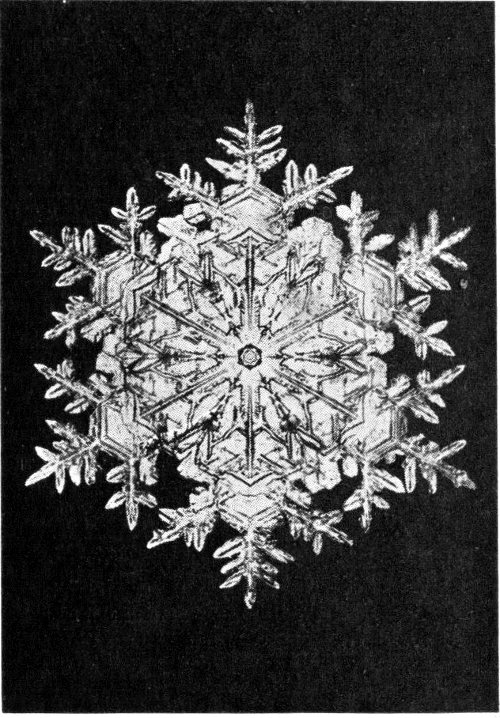
110. Feathery type

111. Clear prism-like branches
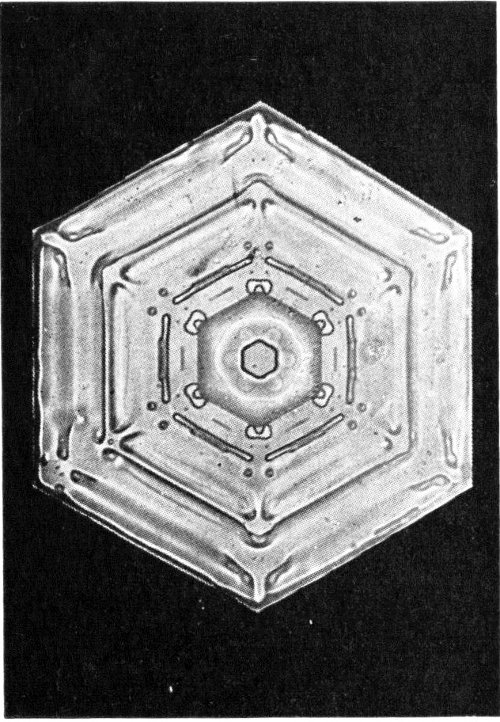
112. Solid type. Probably travelled a long distance
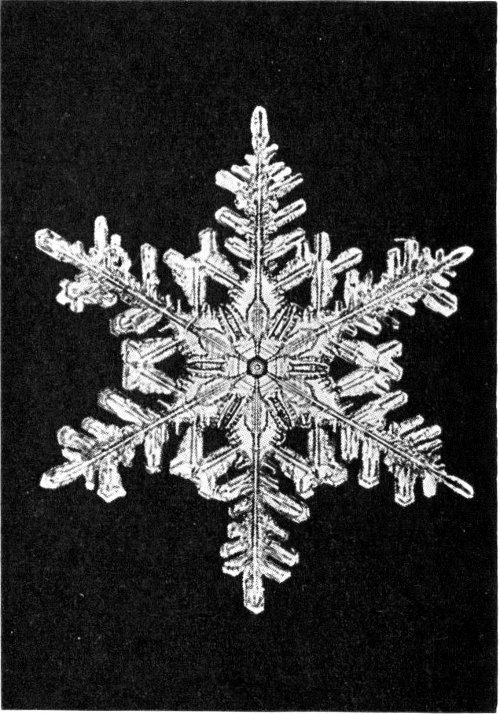
113. Low altitude crystal. Usually feathery and light in construction.
The conversion of liquid water through freezing into a solid crystalline state is certainly a most interesting process, as well as a mysterious one. There are many more difficulties to be encountered by crystal photographers in the study of ice formation, and its minute detail, than in that of either the snow or frost. Still many instructive and very interesting experiments have been made and facts obtained relating to the formation of the ice, and it has recently been possible to secure a valuable set of photographs which are wonderfully interesting, inasmuch as they serve to show the singular formation and development of ice crystal structure from start to finish.
Ice and water are so optically alike, that the formation of these ice crystals cannot be clearly detected without the aid of a microscope. These ethereal ice flowers are extremely frail and thin, less than one one-hundredth of an inch in thickness; and they vary from just a mere microscopic speck, to one-third of an inch or so in tabular diameter.
Generally every freezing body of water contains these beautiful ice crystals; myriads of tiny transparent ice flowers which assume distinct types and groups, more or less symmetrical. In order to watch the growth and development of these ice crystals which build up in such quantities on the surface of pond, river and brook, and which go, as a whole, to form solid ice, certain artificial conditions of light are necessary. These may be simply furnished by using a small mirror placed in a horizontal position beneath the surface of the water which is in process of freezing. Or, if one wishes to make an interesting study of the strange phenomena within doors, it may be quite possible to do so by simply placing water in a pail, and in the bottom of the pail, beneath the water, a mirror in a horizontal position. Of course the water should be kept in a cold room where it will freeze, or beneath an open window. The mirror affords the necessary white background, and in this manner ice in process of freezing may be plainly viewed from its first germ growth to the finished ice crystal.
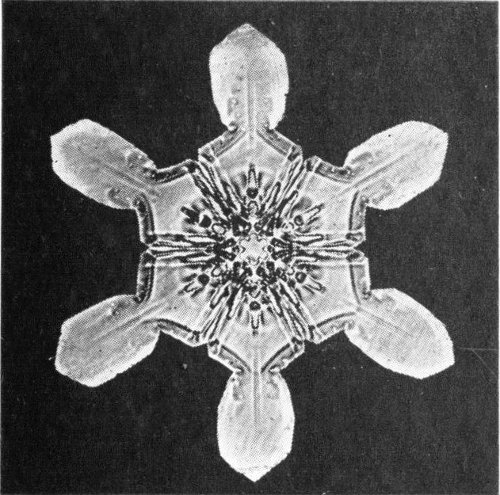
114. Having notably elaborate centre

115. Very elaborate design
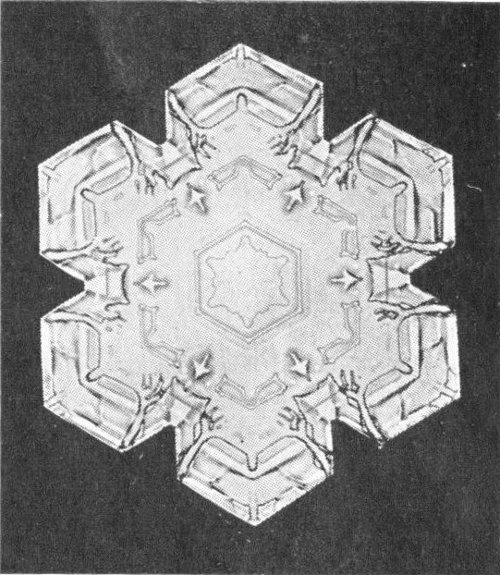
116. The arrow crystal. Six well defined arrows in the design
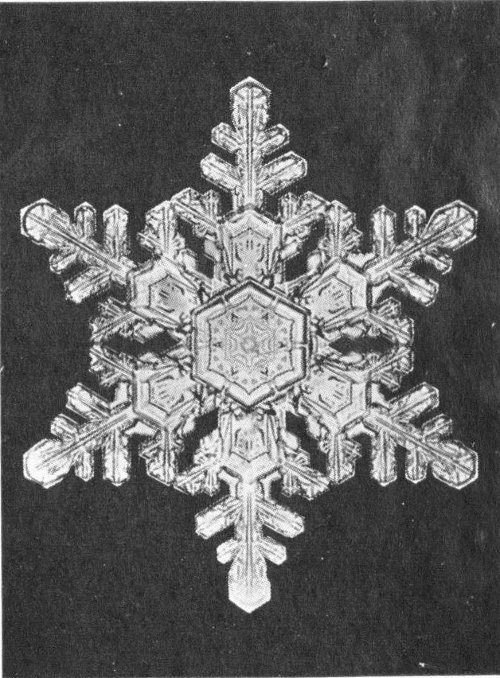
117. Low altitude type
The process by which each water molecule, obedient to the great laws which govern nature, draws together in countless numbers to form and build themselves into countless flower-like ice crystals, which go to form solid ice is a magical, fascinating process, well worth watching.
The types of ice crystals differ, however, upon still surfaces, to those which form upon running or disturbed water. Still, such a similarity exists in all ice crystal formation, and their habits of growth, that one may get a very clear idea of the process of their development by observing it in the simple manner above described.
Their different stages of growth is very clearly divided into five or six types of crystalline formation, and they pass from beginning to end, through the various stages of development as the nuclear, or smooth-edged crystal, the scalloped, the ray-like and the branching stages of growth; after which they lose their individuality by becoming solidified and merged into the solid ice form.
When the ice flowers or crystals first begin to appear, it is usually upon the surface of the water, and close to the sides of the pail. Frequently they push out in long, delicate, needle- or lance-like forms while upon the plain edges of these sharp lances, scallops and delicate serrations quickly follow. But the individual or flower type of crystals which grow and scatter themselves over the surface of the water, do not attach themselves to any object, but grow in a detached fashion, and are really the most interesting crystal for observation and study. These detached crystals following out the laws which govern also the frost and snow crystals from their first stage of development, form a simple, smooth-edged disc of very thin transparent ice, gradually merging into the same, hexagonal, flower-like pattern, which governs the frost and snow crystals, although during the first stages of their development they show no tendency to follow hexagonal outlines. The photographed illustrations showing this type of ice crystal, from its start to finish were most of them taken from indoor observation.

118. High altitude crystal with germs attached

119. A daintily etched centre design
Beginning with photograph No. 128, we have the germ or birth, showing the first stage which the ice crystal assumes in its formation. It is always seen as a round disc of very clear, thin ice.
No. 129 illustrates the second stage of growth in which the tiny serrations or scallops are just beginning to shoot out and form about the germ or disc. Frequently they remain in this stage of development for some time without further change, but when it is zero weather they quickly increase in growth, and soon begin to show clearly defined scallops as shown in photograph No. 130.
In No. 131, the ice crystal has at last begun to assume definite form, and its hexagonal shape is more clearly defined; while in No. 132, we have the completed flower-like outline, and in Nos. 133 and 134 the finished ice flower with its air inclusions of light and shade perfected. This shows the entire process of growth of the commonest type of these ice crystals, after which process they lose their identity and merge into the solid ice film.
However, ice film growth is not wholly supported in this manner, for branches often form upon the under side of the ice film, and grow downward into the water, as shown in photograph No. 135, which is a section of ice with fern-like crystal-growth growing down into the water, thus aiding in growth and solidification. Each type of crystal, and there are five, represents some different characteristic growth—the long, narrow, needle type, the simple stars of six points, and the spherical or discoidal forms; also those resembling coral-like formations.

120. Branchy trigonal crystal

121. An uncommon type
Photograph No. 136 shows how individual ice flowers hamper each other in growth; that the points reaching out into clear water grow and draw to themselves with greater freedom the water molecules, while the points intruded upon or crowded out by other crystals or flowers, cease to grow, and do not interfere with the growth of others.
Nos. 137 and 138 are still other forms of ice-growth, the needle-like, lance-like form which we may frequently observe pushing out from the banks of a small pond or brook. These needle-like forms of ice eventually acquire branches about their entire radius, which grow and merge, with other ice flowers of different types, into solid ice upon the surface of the water.
No. 139 shows this type of ice-crystal completed. These ice-crystals form and rise like magic in early winter, especially upon and around the new ice upon the edges of small brooks, and streams.
“Sometimes the roof no fretwork knew
But silvery mosses that downward grew;
Sometimes it was carved in sharp relief
With quaint arabesques of ice-fern leaf.”
Another very interesting example of ice-growth and formation which we occasionally discover upon the window-panes, and which should not be confounded with the frost work etchings, as it is in reality a thin transparent ice film, which frequently assumes exquisite formations and patterns. In No. 141 a the coral-like branch is a beautiful example of this window-pane ice, while upon the same pane of glass in precisely the same temperature we find another type, as 141 b resembling somewhat the transparent wing of an insect. There are but two distinct types of the ice film etchings, and they are classified as the feather form and the arborescent types. It is presumed that the forming of types is largely governed by the varying thickness of the glass upon which the ice film is deposited, and to the presence or absence of minute frozen particles of ice beneath the film. The feather form seems to develop upon cooler positions of the glass, and where the water film is thinnest.

122. One of the most elaborate crystals shown. Notable for its very dark centre and the curious detail of its border
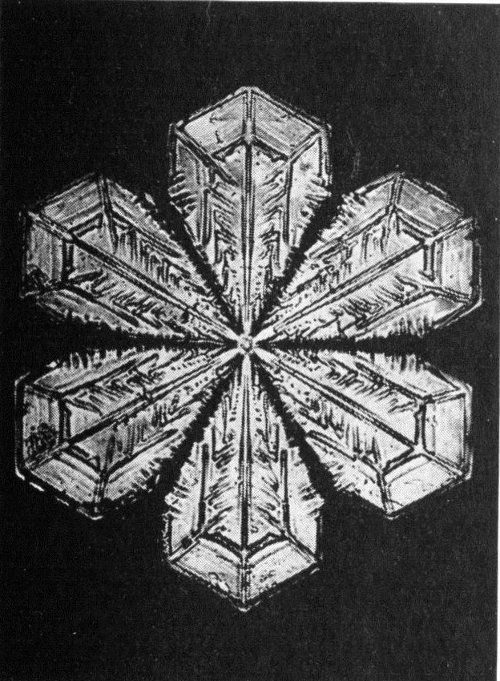
123. A rare design because of its open petal-like formation. Usually such crystals are solid
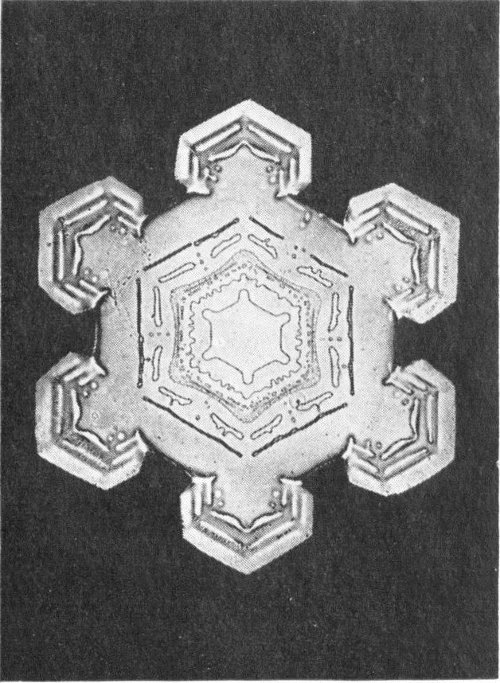
124. Very frigid altitude crystal having remarkably etched centre
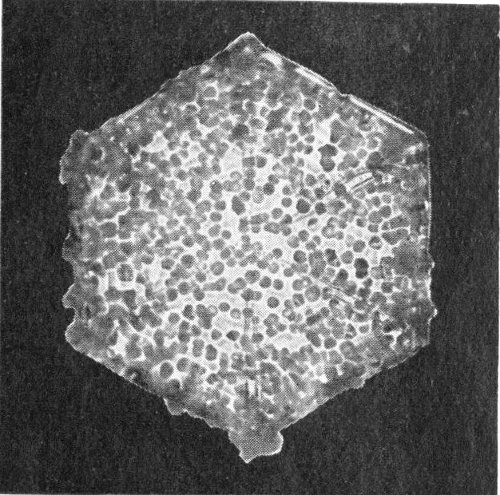
125. A snow crystal covered with granular deposit of frost
Nos. 142, 143, and 144 are all rare examples of window ice. No. 16 shows to perfection a greatly magnified section of the coral-like tracings in detail. This window-pane ice, unlike the frost etchings, is always transparent or opaque water ice.
The ice pictures form in rather an exclusive fashion, and two types never intrude upon each other’s territory, although we often find both types upon one pane of glass, as shown in the photographed illustration Nos. 140 a and 140 b.
The ice films always begin to develop upon the colder portions of the glass first. Feathery plume-like designs form first upon shaded portions, and slowly follow the fading sunlight as it passes from one pane to another, until the entire window is often covered with these transparent ice pictures. During zero weather the feathery types thicken to an astonishing degree, more so than the opposite type, or arborescent ice film.
Another type of ice formation, and an interesting one, which in the photograph resembles somewhat a vegetable root or growth, is a form of ice which develops and grows upon and under peaty soil. These singular little ice columns rise as by magic, and form a miniature forest of tiny ice columns; frequently raising upon their tops the soil, stones, etc., to a height of many inches.

126. Local storm type
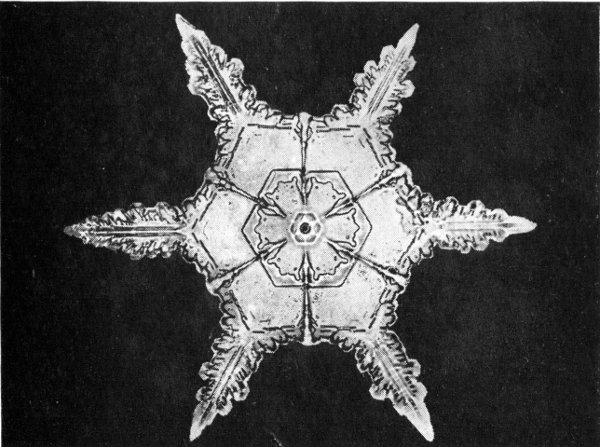
127. Cold high altitude
Nos. 145, 146 and 147, show photographed examples of this type of columnar ice, No. 147 being a largely magnified section of one of these tiny columns in detail. Icicles are another interesting phenomenon belonging to ice study. They are evidently produced by the thawing of snow, and we frequently discover “freak” icicles hanging pendent from the house eaves during a thaw. They are, in a way, one of the many mysteries pertaining, and to be classed as ice crystallisations, and are closely related to the wonderful stalactite formations found in deep caves.
Beautiful beyond powers of description are the magical, fairy-like scenes which follow the passing of a great ice-storm. If you are out of doors just after such a storm, when the first rays of the sun begin to shine forth, lighting and touching every ice-sheathed twig with gold, and before the ice has begun to melt and fall from the trees, you can well imagine that you are catching a fleeting glimpse of fairyland! Trees that before the storm waved their leaf-stripped branches, bare and unlovely, in wailing symphony, tuned by the bleak wintry blast, have suddenly been clothed anew and made beautiful for a brief time, by their silvery coating of ice. Each tiny twig glitters and scintillates and crackles beneath the pale wintry sunshine; beautiful beyond words to picture.
These ice-storms occur more frequently in January, and are usually followed by a warm wave. They are seen in all their beauty in the New England States. Frequently after such an ice-storm there is a noticeable swelling and expansion of twigs and buds; the first suggestion of verdure and an early spring.
It is intended in this article but to touch upon the simple structural formation of the ice. There are still many important facts to discover, many interesting problems to solve. It would be interesting to know why the ice crystals which originate and have their being in the same body of water, and under precisely the same conditions of temperature vary so greatly in their structural formation.
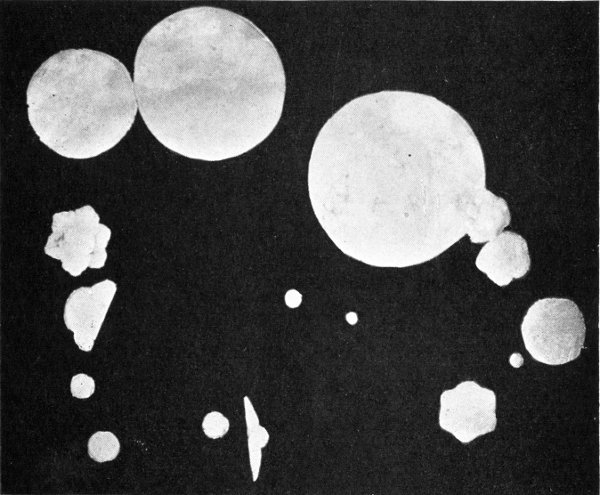
128. Germ or birth of ice crystal
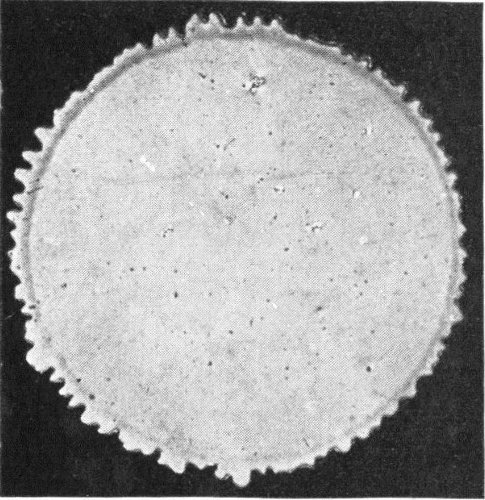
129. Discoidal ice crystal. Second stage in which crimps begin to appear around the edge of disc
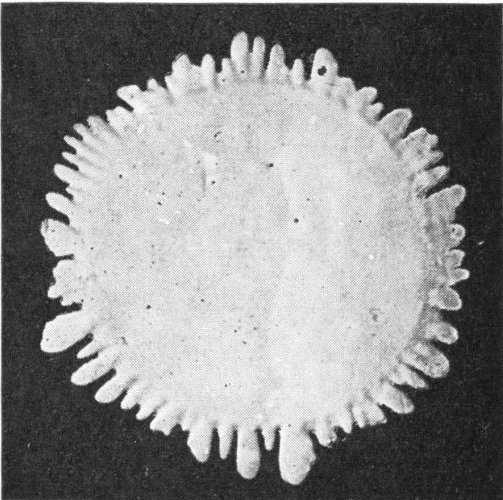
130. Third stage of development. Scallops well defined
Ice crystallisation in all its branches is a fascinating and wonderfully instructive study. It is still in its infancy, there is much as yet undiscovered material for experiment awaiting both the student and the camera specialist.
“Sometimes it was simply smooth and clear
For the gladness of Heaven to shine through, and here
He had caught the nodding bulrush tops
And hung them thickly with diamond drops,
That crystallised the beams of moon and sun,
And made a star of every one:
No mortal builder’s rare device
Could match this winter-palace of ice.”
—Lowell.
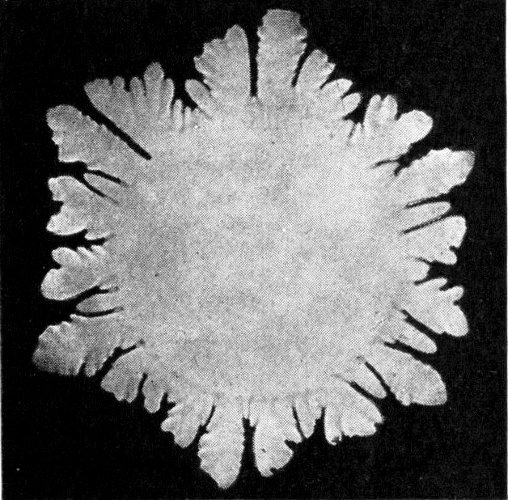
131. Fourth stage, flower-like shape beginning to show
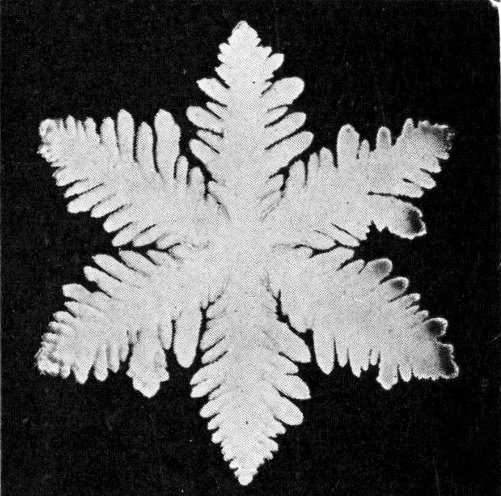
132. Ice flower completed
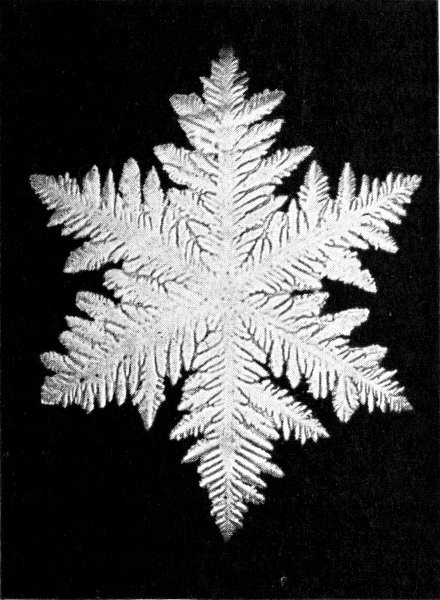
133. Flower-like shape fully formed
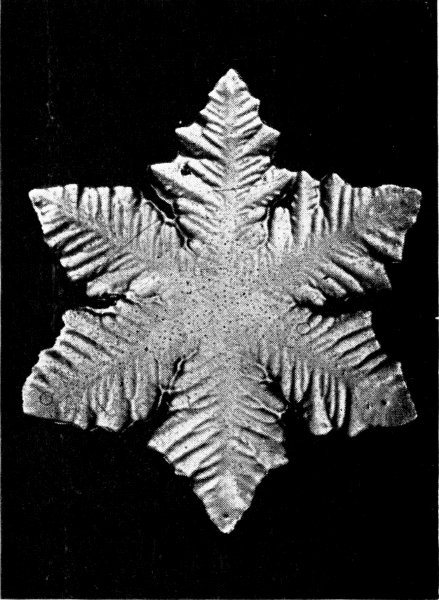
134. Ice flower beginning to show shadings

135. Ice crystals growing downwards into the brook
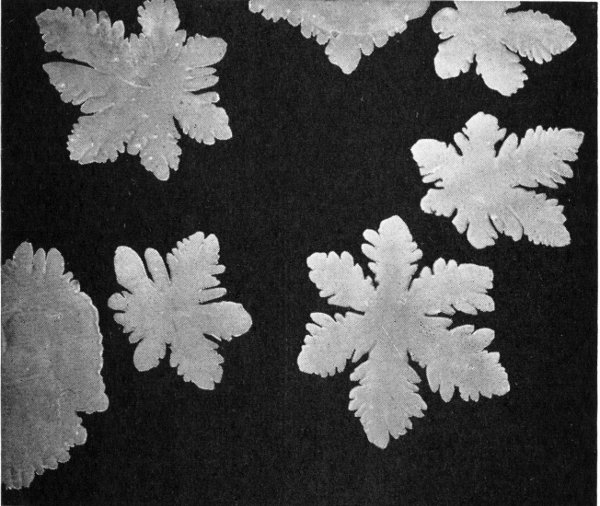
136. Group of ice crystals. Observe how in growing they avoid other
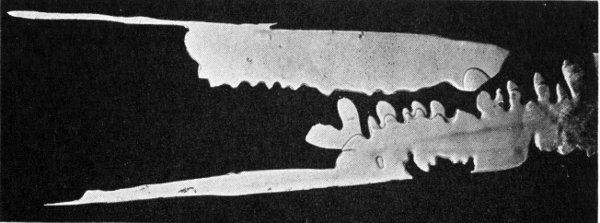
137. First stage. Lance-like form seen pushing out from banks of brooks
“We knew it would rain for the poplar’s showed
The white of their leaves, the amber grain
Shrunk in the wind and the lightning now
Is tangled in tremulous skeins of rain.”
—Aldrich.
Fickle April, the season of sunshine and rain, comes on apace; and the bluebird, that “comes first you know, like a violet that has taken wings,” has piped his clear advance notes in the hedges, and a bright message of promise his cheery song always brings, of blossoms and verdure soon to follow.
Surely each changing month brings with its advent its own peculiar charms. The seasons of frost, snow and ice are full of beauty to those of us who have looked into, and delight to ponder over, the many secret ways of nature. But April with its sudden showers, which eventually do bring forth the May flowers, we hail with hope; and are only too happy to leave behind us, as a pleasant remembrance, the more sombre, frozen charms of winter.
The ice-bound brooks have at last burst their fetters, in the meadows by the little streams the stems of the willows are yellowing, and here and there the pussy willows, in their silver, furry coats, are bursting forth; the alders have sprouted, and from the ooze of the marshes the swamp-cabbages are pushing forth their sharp-pointed purple sprouts. While the honking geese, flock after flock, trail wedge-like in the early mists of the morning, across the gray skies. In the sedgy places where the flags are just sprouting the “peepers” at twilight begin their spring chorus, and with the advent of all these signs of advancing spring, we realise that the “backbone of winter” has fairly been broken, and the earth is preparing and waiting for April, with its beneficent showers to bring new life into all dormant buds and vegetation beneath the earth and to arouse them once more from their long winter’s lethargy.

138. Second stage of lance-like crystal

139. Lance-like form completed
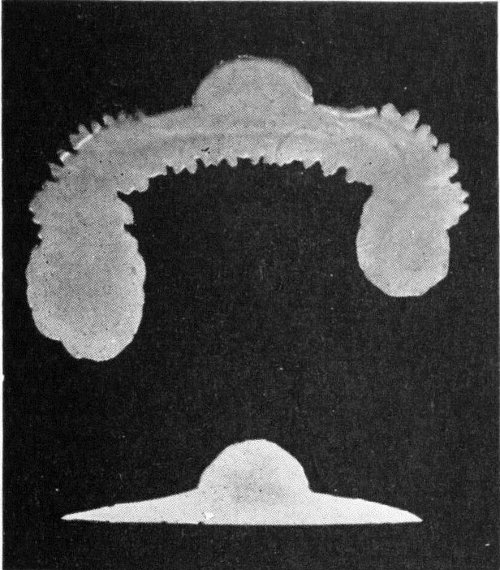
140. Freak ice crystals
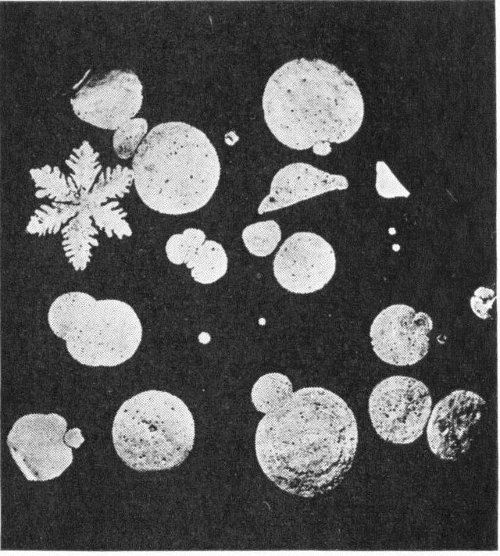
140 b. Group of ice crystals containing germs, “freaks” and one completed ice flower
“April cold with dropping rain
Willows and lilac bring again
With the whistle of returning birds.”
Since the rain plays such an important role in nature’s plans, certain facts concerning its origin, and the clouds which govern its formation and fall, will prove of interest.
The prior causes of rain are due to the evaporation of moisture which is constantly going on, from ocean, lake and river, and all vegetation; until the air is freely saturated with moisture thus evaporated. Then “Mother Nature” assists, causing turbulent, driving winds to rise, and all her elements combine forthwith, to precipitate the moisture; and then follows the rain.
The rays of the sun falling upon the air stratum nearest the earth cause it to arise and expand. Thus, as a result, the clouds are formed. The ascending air leaves a partial vacuum below, which causes surrounding air to rush inward; which in turn causes winds. Once this process starts, it tends to grow and perpetuate itself. The inrushing air below forces the rising air still higher and higher, which causes dense clouds to form and rush upwards to great heights. Both snow and rain fall as a result of warm moist air being forced upward to a great altitude, and its moisture condensed.
The smaller raindrops fall from the lower cloud strata, but the larger drops descend from a much higher altitude. In the higher, frigid altitudes where snow, and the granular snow pellets are formed and exist, in the upper sections of the clouds; by falling down through the vast cloud regions below, they gradually collect minute cloud particles, and smaller drops in their travels, and thus, by melting, as they encounter warmer air currents, form the very large, high-altitude raindrops.
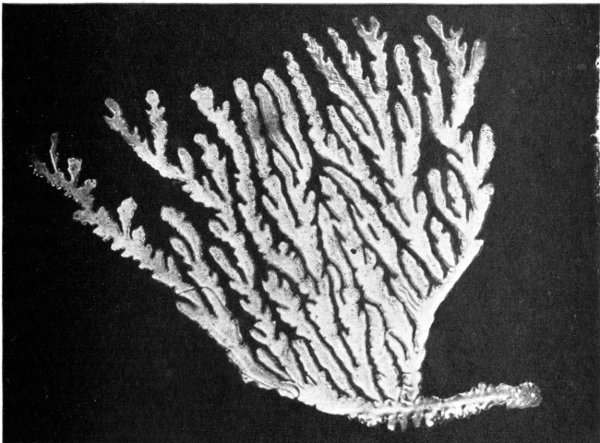
141 a. Coral-like branch showing the “feather type” in detail
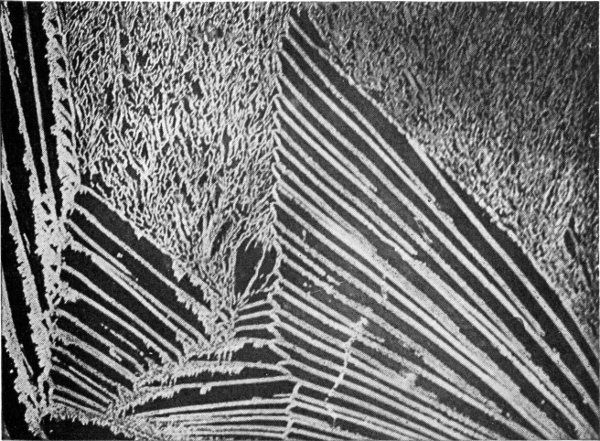
141 b. Window-pane ice. Two forms, the arborescent and feather types
It has not until quite recently been possible to measure with any degree of accuracy, and photograph raindrops in the exact size in which they fall. But now that it has become possible to do this, it is most interesting to know the process. It is also most important to be able to know that certain types of raindrops fall during given storms. For instance, a very large type of raindrop emanates from a violent thunder-storm, when there is vivid lightning. Another distinct type belongs to the general storm, and there are many others, their form and size being governed entirely by the clouds and the character of the storms from which they fall.
Hundreds of samples of raindrop impressions have recently been secured, and the method employed to collect and photograph them is most unique. To secure these raindrop impressions, emanating from various storms and clouds, a shallow tin receptacle about four inches in diameter was used, the bottom of the tin being covered with fine, uncompacted flour an inch deep. The flour was then exposed to the rain for about four seconds, and the raindrops allowed to remain in the flour until each drop had hardened as it fell. These dough pellets, or raindrop impressions were found, in every instance, to correspond very closely in size to the raindrops as they fell. When thoroughly dried out they were carefully removed from their bed of flour, labelled and photographed. This method of determining the relative dimensions of raindrops which fall during various types of storms, has proven to be the most satisfactory method as yet discovered.

142. Beautiful type of window-ice growing like delicate sea-weed
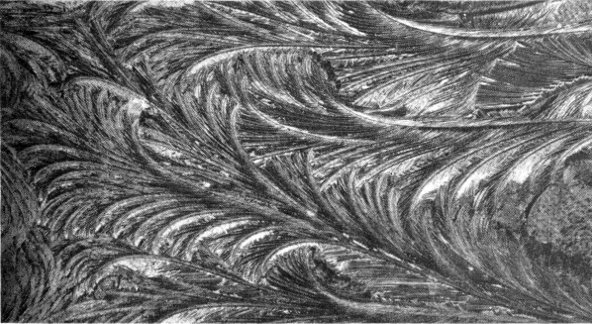
143. Window-pane ice. Resembling pampas grass
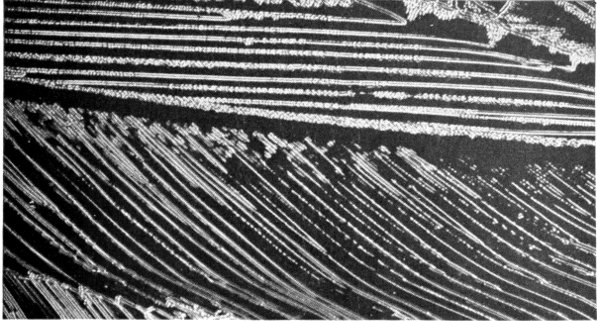
144. Another type of window-pane ice
The large raindrops are invariably great travellers. The larger the drops the greater the height from which they fell. Some of them travel a distance of five to eight miles before reaching the earth.
Raindrops falling from very high altitudes invariably start out as snowflakes, as the upper section of a rain-cloud, when formed in the high frigid altitudes, is usually composed of snow. The general rain-storm usually furnishes small to medium-sized drops. But sudden thunder-storms, where the clouds gather in dense, mountain-like formations, as the one shown in the photographed illustration, furnish the very largest raindrops which fall, unless we except those which may sometimes result from the melting of large hailstones, which emanate sometimes from very violent storms of the whirling, tornado type.
The cold gray rains of early spring, which frequently turn to ice in falling, and sheathe the branches of trees with a glittering coat of icy mail, change in character as spring and the warmer weather advances.
The mid-summer thundershower is still another type, and an impressive one. When all nature lies gasping and parched under the withering heat of a torrid sun, when the pebbly beds of the little streams are brown and dry, and the thirsty cattle low plaintively in the sun-scorched pastures, then suddenly, the south winds send a long-drawn, whispering sigh through the motionless tree-tops; the poplar leaves begin to tremble and toss, and faster and faster the thunder heads begin to roll up and assemble, and rush together, with low ominous mutterings.
The clouds, coppery-hued and black, and full of menace, hang low, and almost seem to touch the hills, rising winds chase each other and catch up stray dead leaves and débris, sending them whirling and dancing in fantastic eddies; while the startled swallows wheel low before the rushing, mighty tumult of the approaching storm.

145. Another example of Columnar ice. Formation like vegetable roots

146. Columnar ice, found under peaty soil
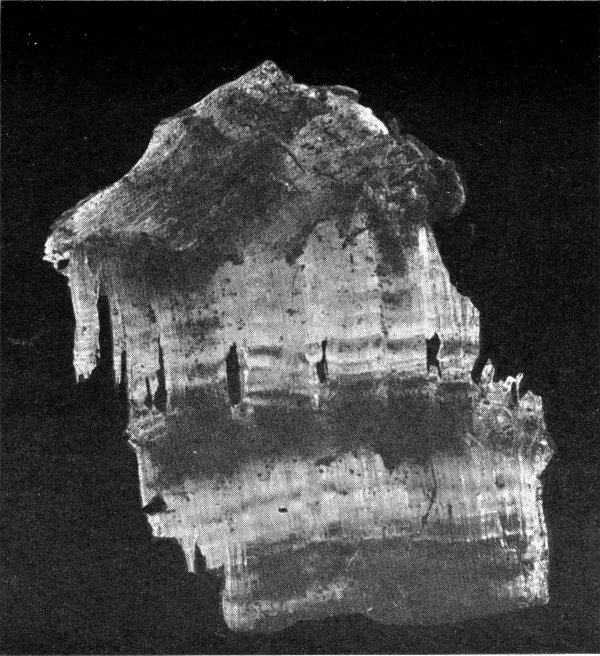
147. Columnar ice, section shown in detail, largely magnified
Nothing can compare in grandeur, to the marshalling of Nature’s forces together and the raging fury of a great thunder-storm. Truly the roar of the thunder may well be likened to Heaven’s artillery, and no pyrotechnic display ever equals that which the jagged, forked lightning creates amid the inky, ominous clouds of the heavens. And then the finale; the low, distant, retreating growls of the passing thunder, the gradual lifting of the clouds, and then like magic, their leaden, ominous curtains are swept aside, and the happy sunshine is with us again, and the earth, refreshed and purified by the grateful shower, gasps no more in the throes of heat.
And how lovely is nature after such a shower. How sweet and fresh the air, and how each blade of grass, and all vegetation sparkles and scintillates anew. The little mountain torrent which trickled so listlessly, just a mere silver thread among its mossy stones, has gained new courage and strength since the shower, and its gurgling may plainly be heard as it now rushes madly down the incline. The meadow brook has overflowed its banks, and formed a miniature lake, in which the grateful cattle stand contentedly knee-deep. All the birds rejoice, and the robins, noisiest of them all, pause to plume afresh their wet feathers, and pipe their peculiar rain song; a distinct note of gratitude and joy for the coming of the rain.
The rain, besides playing a most important part in aiding all vegetation, is an acknowledged and powerful agent in the cleansing and purification of the atmosphere. Foul air is dissipated, and dust and particles which rise in clouds and permeate the air we breathe, are beaten to the earth and dissipated by the kindly rain.
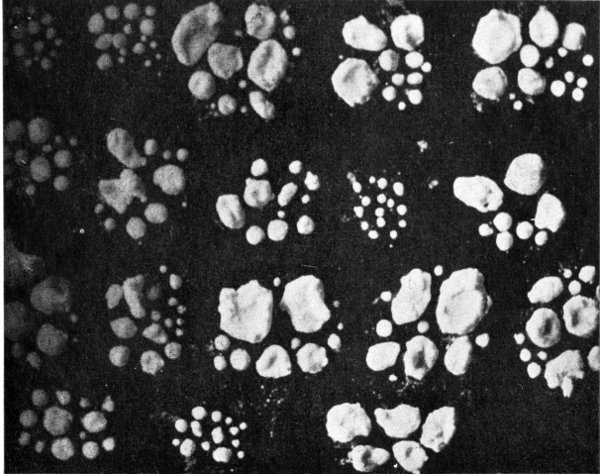
148. Very great thunder-storm drops
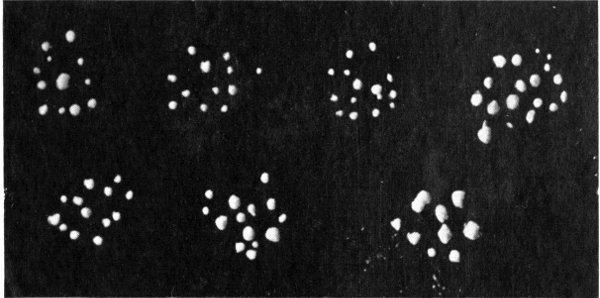
149. Rain from high cirro-stratus clouds
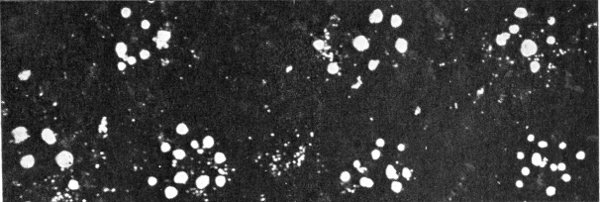
150. Rain from low nimbus clouds
Storms which arise in pleasant summer weather are frequently caused by the diurnal breezes which ascend mountain slopes causing sudden clouds to assemble, and thunder-storms to follow. Violent thunder-storms are caused by the intensely hot air which arises from the earth in summer, and which encounters the cooler air descending.
Frequently “heat lightning” may be observed flickering fitfully in the skies, when there is no rain. When such is the case, you may be assured that a storm cloud hovers somewhere in that direction, although it may not be visible, or its thunder audible. Whenever the lightning is brilliant and continuous the storm is sure to be of a violent character, when frequently the destructive bolts are fifty miles away.
The rainbow, that wonderfully beautiful bow of prismatic tints, which sometimes throws its ethereal arch across the heavens for a brief while, is caused by the reflection of the sun’s rays shining upon drops of rain, the colours being arranged in definite order; red, orange, yellow, green, blue, indigo and violet. The lunar rainbow, which occasionally forms at night when the moon shines, is not of frequent occurrence, but very beautiful when it does deign to show itself. Its colouring is not nearly as distinct at the rainbow, but ghostly, and of a pale-yellowish tint. Frequently a double rainbow is seen after a shower; this is but a reflection of the rainbow proper, but indescribably beautiful.
In the coming of the rainbow we have a Biblical symbol. It is spoken of in Genesis, and was used as a token of the Covenant; as a Divine promise to man, that the earth should never again be destroyed by flood.
There are numberless so-called signs, which are considered reliable indications of rain. Almost invariably a continuous south wind will, in most localities, bring in its wake rain in a few days. On the contrary, a continuous north wind is liable to dispel all rain signs for a time.
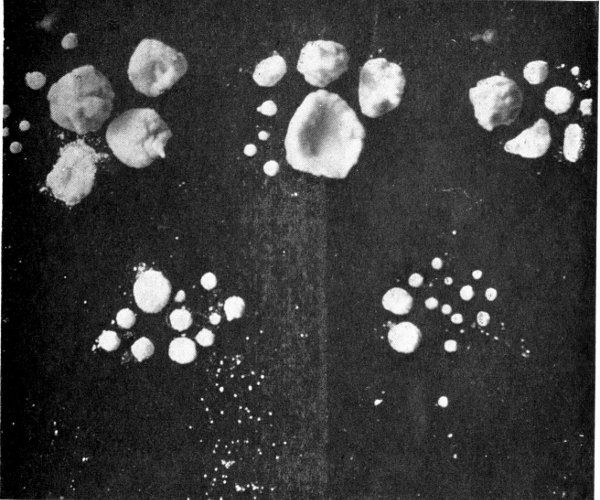
151. Thunder and hail storm type
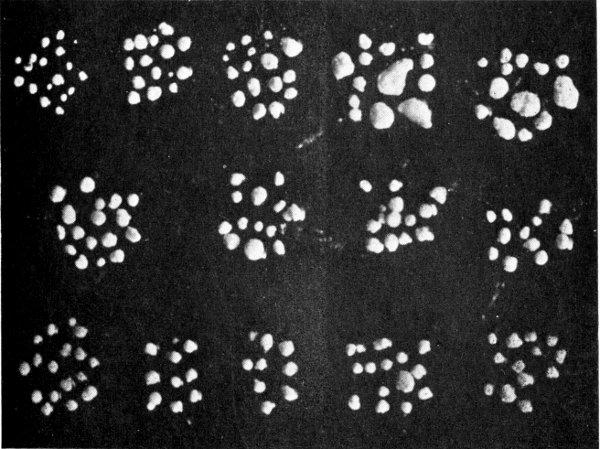
152. From a great rain storm which lasted 15 hours
A “mackerel sky,” that is, a sky covered with a wide expanse of small silvery clouds, round in shape, is another rather sure indication of rain; salmon-coloured, leaden, or silvery clouds are usually indications of falling weather, and when at sunset the clouds of the west are brightly coloured, red or flame-coloured, afterwards followed by lighter hues, streaking up from the place where the sun disappeared, and stretching far across the sky, finally converging to a common point on the opposite horizon, you may be quite certain that somewhere within line of the sun, there is a heavy storm brewing; although it may be invisible, and hidden by the earth.
We know that in certain parts of the earth the rain seldom falls. In Lima (Peru), Thebes (Egypt), and in certain sections of North Africa they very rarely have rain. The presence of forests tends to increase the rainfall. Over the ocean it is always clear when the trade winds are blowing steadily, while rains fall continuously in the zone of calms.
Some countries are rarely free from rains; in Hindustan, Brazil and Guadeloupe the rain is almost continuous, while certain localities are noted for prolonged seasons of either drought or rain, which occur at stated periods, as in California.
The benefits derived from the rain are unlimited. After the visitation of a great and prolonged drought, when lakes and rivers and their many tributaries, the little mountain torrents which feed them, are dry for lack of rain; when the gardens and all vegetation at last succumb and shrivel for lack of moisture; when we really endure great bodily privation, and domestic animals suffer for lack of water, then we may realise fully, what a wise and necessary provision the rain is to us.

153. Thunder cloud

154. Nimbus or low stratus clouds
It seems therefore that there is always a great promise and hope embodied in the providential falling of the rain at such a crisis; nothing can express the thought I would convey more clearly than the following beautiful lines:
“Hast thou forgotten God who gives the rain?
Plentiful and merciful the long showers pour
On parching field where dust and drouth were sore,
Yet, will thine eyes watch out the night again?
“What hope had earth gasping at yesternoon?
What hope hast thou whose comfort shall be soon.
To-morrow where the upland fields lay black,
Thou shalt go forth and look on life come back.
Harvest shall follow seed-time yet again.
Hast thou forgotten God who gives the rain?”
—Earle.
THE END

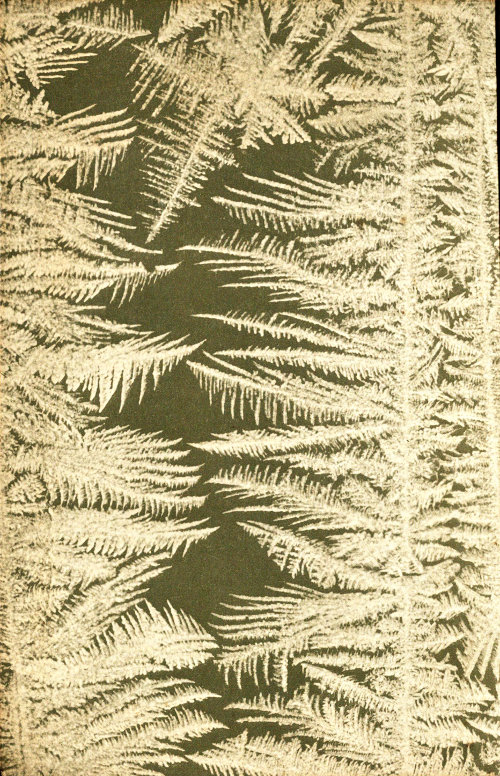
End of the Project Gutenberg EBook of Water Wonders Every Child Should Know, by
Jean M. Thompson
*** END OF THIS PROJECT GUTENBERG EBOOK WATER WONDERS EVERY CHILD ***
***** This file should be named 56572-h.htm or 56572-h.zip *****
This and all associated files of various formats will be found in:
http://www.gutenberg.org/5/6/5/7/56572/
Produced by Stephen Hutcheson and the Online Distributed
Proofreading Team at http://www.pgdp.net
Updated editions will replace the previous one--the old editions will
be renamed.
Creating the works from print editions not protected by U.S. copyright
law means that no one owns a United States copyright in these works,
so the Foundation (and you!) can copy and distribute it in the United
States without permission and without paying copyright
royalties. Special rules, set forth in the General Terms of Use part
of this license, apply to copying and distributing Project
Gutenberg-tm electronic works to protect the PROJECT GUTENBERG-tm
concept and trademark. Project Gutenberg is a registered trademark,
and may not be used if you charge for the eBooks, unless you receive
specific permission. If you do not charge anything for copies of this
eBook, complying with the rules is very easy. You may use this eBook
for nearly any purpose such as creation of derivative works, reports,
performances and research. They may be modified and printed and given
away--you may do practically ANYTHING in the United States with eBooks
not protected by U.S. copyright law. Redistribution is subject to the
trademark license, especially commercial redistribution.
START: FULL LICENSE
THE FULL PROJECT GUTENBERG LICENSE
PLEASE READ THIS BEFORE YOU DISTRIBUTE OR USE THIS WORK
To protect the Project Gutenberg-tm mission of promoting the free
distribution of electronic works, by using or distributing this work
(or any other work associated in any way with the phrase "Project
Gutenberg"), you agree to comply with all the terms of the Full
Project Gutenberg-tm License available with this file or online at
www.gutenberg.org/license.
Section 1. General Terms of Use and Redistributing Project
Gutenberg-tm electronic works
1.A. By reading or using any part of this Project Gutenberg-tm
electronic work, you indicate that you have read, understand, agree to
and accept all the terms of this license and intellectual property
(trademark/copyright) agreement. If you do not agree to abide by all
the terms of this agreement, you must cease using and return or
destroy all copies of Project Gutenberg-tm electronic works in your
possession. If you paid a fee for obtaining a copy of or access to a
Project Gutenberg-tm electronic work and you do not agree to be bound
by the terms of this agreement, you may obtain a refund from the
person or entity to whom you paid the fee as set forth in paragraph
1.E.8.
1.B. "Project Gutenberg" is a registered trademark. It may only be
used on or associated in any way with an electronic work by people who
agree to be bound by the terms of this agreement. There are a few
things that you can do with most Project Gutenberg-tm electronic works
even without complying with the full terms of this agreement. See
paragraph 1.C below. There are a lot of things you can do with Project
Gutenberg-tm electronic works if you follow the terms of this
agreement and help preserve free future access to Project Gutenberg-tm
electronic works. See paragraph 1.E below.
1.C. The Project Gutenberg Literary Archive Foundation ("the
Foundation" or PGLAF), owns a compilation copyright in the collection
of Project Gutenberg-tm electronic works. Nearly all the individual
works in the collection are in the public domain in the United
States. If an individual work is unprotected by copyright law in the
United States and you are located in the United States, we do not
claim a right to prevent you from copying, distributing, performing,
displaying or creating derivative works based on the work as long as
all references to Project Gutenberg are removed. Of course, we hope
that you will support the Project Gutenberg-tm mission of promoting
free access to electronic works by freely sharing Project Gutenberg-tm
works in compliance with the terms of this agreement for keeping the
Project Gutenberg-tm name associated with the work. You can easily
comply with the terms of this agreement by keeping this work in the
same format with its attached full Project Gutenberg-tm License when
you share it without charge with others.
1.D. The copyright laws of the place where you are located also govern
what you can do with this work. Copyright laws in most countries are
in a constant state of change. If you are outside the United States,
check the laws of your country in addition to the terms of this
agreement before downloading, copying, displaying, performing,
distributing or creating derivative works based on this work or any
other Project Gutenberg-tm work. The Foundation makes no
representations concerning the copyright status of any work in any
country outside the United States.
1.E. Unless you have removed all references to Project Gutenberg:
1.E.1. The following sentence, with active links to, or other
immediate access to, the full Project Gutenberg-tm License must appear
prominently whenever any copy of a Project Gutenberg-tm work (any work
on which the phrase "Project Gutenberg" appears, or with which the
phrase "Project Gutenberg" is associated) is accessed, displayed,
performed, viewed, copied or distributed:
This eBook is for the use of anyone anywhere in the United States and
most other parts of the world at no cost and with almost no
restrictions whatsoever. You may copy it, give it away or re-use it
under the terms of the Project Gutenberg License included with this
eBook or online at www.gutenberg.org. If you are not located in the
United States, you'll have to check the laws of the country where you
are located before using this ebook.
1.E.2. If an individual Project Gutenberg-tm electronic work is
derived from texts not protected by U.S. copyright law (does not
contain a notice indicating that it is posted with permission of the
copyright holder), the work can be copied and distributed to anyone in
the United States without paying any fees or charges. If you are
redistributing or providing access to a work with the phrase "Project
Gutenberg" associated with or appearing on the work, you must comply
either with the requirements of paragraphs 1.E.1 through 1.E.7 or
obtain permission for the use of the work and the Project Gutenberg-tm
trademark as set forth in paragraphs 1.E.8 or 1.E.9.
1.E.3. If an individual Project Gutenberg-tm electronic work is posted
with the permission of the copyright holder, your use and distribution
must comply with both paragraphs 1.E.1 through 1.E.7 and any
additional terms imposed by the copyright holder. Additional terms
will be linked to the Project Gutenberg-tm License for all works
posted with the permission of the copyright holder found at the
beginning of this work.
1.E.4. Do not unlink or detach or remove the full Project Gutenberg-tm
License terms from this work, or any files containing a part of this
work or any other work associated with Project Gutenberg-tm.
1.E.5. Do not copy, display, perform, distribute or redistribute this
electronic work, or any part of this electronic work, without
prominently displaying the sentence set forth in paragraph 1.E.1 with
active links or immediate access to the full terms of the Project
Gutenberg-tm License.
1.E.6. You may convert to and distribute this work in any binary,
compressed, marked up, nonproprietary or proprietary form, including
any word processing or hypertext form. However, if you provide access
to or distribute copies of a Project Gutenberg-tm work in a format
other than "Plain Vanilla ASCII" or other format used in the official
version posted on the official Project Gutenberg-tm web site
(www.gutenberg.org), you must, at no additional cost, fee or expense
to the user, provide a copy, a means of exporting a copy, or a means
of obtaining a copy upon request, of the work in its original "Plain
Vanilla ASCII" or other form. Any alternate format must include the
full Project Gutenberg-tm License as specified in paragraph 1.E.1.
1.E.7. Do not charge a fee for access to, viewing, displaying,
performing, copying or distributing any Project Gutenberg-tm works
unless you comply with paragraph 1.E.8 or 1.E.9.
1.E.8. You may charge a reasonable fee for copies of or providing
access to or distributing Project Gutenberg-tm electronic works
provided that
* You pay a royalty fee of 20% of the gross profits you derive from
the use of Project Gutenberg-tm works calculated using the method
you already use to calculate your applicable taxes. The fee is owed
to the owner of the Project Gutenberg-tm trademark, but he has
agreed to donate royalties under this paragraph to the Project
Gutenberg Literary Archive Foundation. Royalty payments must be paid
within 60 days following each date on which you prepare (or are
legally required to prepare) your periodic tax returns. Royalty
payments should be clearly marked as such and sent to the Project
Gutenberg Literary Archive Foundation at the address specified in
Section 4, "Information about donations to the Project Gutenberg
Literary Archive Foundation."
* You provide a full refund of any money paid by a user who notifies
you in writing (or by e-mail) within 30 days of receipt that s/he
does not agree to the terms of the full Project Gutenberg-tm
License. You must require such a user to return or destroy all
copies of the works possessed in a physical medium and discontinue
all use of and all access to other copies of Project Gutenberg-tm
works.
* You provide, in accordance with paragraph 1.F.3, a full refund of
any money paid for a work or a replacement copy, if a defect in the
electronic work is discovered and reported to you within 90 days of
receipt of the work.
* You comply with all other terms of this agreement for free
distribution of Project Gutenberg-tm works.
1.E.9. If you wish to charge a fee or distribute a Project
Gutenberg-tm electronic work or group of works on different terms than
are set forth in this agreement, you must obtain permission in writing
from both the Project Gutenberg Literary Archive Foundation and The
Project Gutenberg Trademark LLC, the owner of the Project Gutenberg-tm
trademark. Contact the Foundation as set forth in Section 3 below.
1.F.
1.F.1. Project Gutenberg volunteers and employees expend considerable
effort to identify, do copyright research on, transcribe and proofread
works not protected by U.S. copyright law in creating the Project
Gutenberg-tm collection. Despite these efforts, Project Gutenberg-tm
electronic works, and the medium on which they may be stored, may
contain "Defects," such as, but not limited to, incomplete, inaccurate
or corrupt data, transcription errors, a copyright or other
intellectual property infringement, a defective or damaged disk or
other medium, a computer virus, or computer codes that damage or
cannot be read by your equipment.
1.F.2. LIMITED WARRANTY, DISCLAIMER OF DAMAGES - Except for the "Right
of Replacement or Refund" described in paragraph 1.F.3, the Project
Gutenberg Literary Archive Foundation, the owner of the Project
Gutenberg-tm trademark, and any other party distributing a Project
Gutenberg-tm electronic work under this agreement, disclaim all
liability to you for damages, costs and expenses, including legal
fees. YOU AGREE THAT YOU HAVE NO REMEDIES FOR NEGLIGENCE, STRICT
LIABILITY, BREACH OF WARRANTY OR BREACH OF CONTRACT EXCEPT THOSE
PROVIDED IN PARAGRAPH 1.F.3. YOU AGREE THAT THE FOUNDATION, THE
TRADEMARK OWNER, AND ANY DISTRIBUTOR UNDER THIS AGREEMENT WILL NOT BE
LIABLE TO YOU FOR ACTUAL, DIRECT, INDIRECT, CONSEQUENTIAL, PUNITIVE OR
INCIDENTAL DAMAGES EVEN IF YOU GIVE NOTICE OF THE POSSIBILITY OF SUCH
DAMAGE.
1.F.3. LIMITED RIGHT OF REPLACEMENT OR REFUND - If you discover a
defect in this electronic work within 90 days of receiving it, you can
receive a refund of the money (if any) you paid for it by sending a
written explanation to the person you received the work from. If you
received the work on a physical medium, you must return the medium
with your written explanation. The person or entity that provided you
with the defective work may elect to provide a replacement copy in
lieu of a refund. If you received the work electronically, the person
or entity providing it to you may choose to give you a second
opportunity to receive the work electronically in lieu of a refund. If
the second copy is also defective, you may demand a refund in writing
without further opportunities to fix the problem.
1.F.4. Except for the limited right of replacement or refund set forth
in paragraph 1.F.3, this work is provided to you 'AS-IS', WITH NO
OTHER WARRANTIES OF ANY KIND, EXPRESS OR IMPLIED, INCLUDING BUT NOT
LIMITED TO WARRANTIES OF MERCHANTABILITY OR FITNESS FOR ANY PURPOSE.
1.F.5. Some states do not allow disclaimers of certain implied
warranties or the exclusion or limitation of certain types of
damages. If any disclaimer or limitation set forth in this agreement
violates the law of the state applicable to this agreement, the
agreement shall be interpreted to make the maximum disclaimer or
limitation permitted by the applicable state law. The invalidity or
unenforceability of any provision of this agreement shall not void the
remaining provisions.
1.F.6. INDEMNITY - You agree to indemnify and hold the Foundation, the
trademark owner, any agent or employee of the Foundation, anyone
providing copies of Project Gutenberg-tm electronic works in
accordance with this agreement, and any volunteers associated with the
production, promotion and distribution of Project Gutenberg-tm
electronic works, harmless from all liability, costs and expenses,
including legal fees, that arise directly or indirectly from any of
the following which you do or cause to occur: (a) distribution of this
or any Project Gutenberg-tm work, (b) alteration, modification, or
additions or deletions to any Project Gutenberg-tm work, and (c) any
Defect you cause.
Section 2. Information about the Mission of Project Gutenberg-tm
Project Gutenberg-tm is synonymous with the free distribution of
electronic works in formats readable by the widest variety of
computers including obsolete, old, middle-aged and new computers. It
exists because of the efforts of hundreds of volunteers and donations
from people in all walks of life.
Volunteers and financial support to provide volunteers with the
assistance they need are critical to reaching Project Gutenberg-tm's
goals and ensuring that the Project Gutenberg-tm collection will
remain freely available for generations to come. In 2001, the Project
Gutenberg Literary Archive Foundation was created to provide a secure
and permanent future for Project Gutenberg-tm and future
generations. To learn more about the Project Gutenberg Literary
Archive Foundation and how your efforts and donations can help, see
Sections 3 and 4 and the Foundation information page at
www.gutenberg.org
Section 3. Information about the Project Gutenberg Literary Archive Foundation
The Project Gutenberg Literary Archive Foundation is a non profit
501(c)(3) educational corporation organized under the laws of the
state of Mississippi and granted tax exempt status by the Internal
Revenue Service. The Foundation's EIN or federal tax identification
number is 64-6221541. Contributions to the Project Gutenberg Literary
Archive Foundation are tax deductible to the full extent permitted by
U.S. federal laws and your state's laws.
The Foundation's principal office is in Fairbanks, Alaska, with the
mailing address: PO Box 750175, Fairbanks, AK 99775, but its
volunteers and employees are scattered throughout numerous
locations. Its business office is located at 809 North 1500 West, Salt
Lake City, UT 84116, (801) 596-1887. Email contact links and up to
date contact information can be found at the Foundation's web site and
official page at www.gutenberg.org/contact
For additional contact information:
Dr. Gregory B. Newby
Chief Executive and Director
gbnewby@pglaf.org
Section 4. Information about Donations to the Project Gutenberg
Literary Archive Foundation
Project Gutenberg-tm depends upon and cannot survive without wide
spread public support and donations to carry out its mission of
increasing the number of public domain and licensed works that can be
freely distributed in machine readable form accessible by the widest
array of equipment including outdated equipment. Many small donations
($1 to $5,000) are particularly important to maintaining tax exempt
status with the IRS.
The Foundation is committed to complying with the laws regulating
charities and charitable donations in all 50 states of the United
States. Compliance requirements are not uniform and it takes a
considerable effort, much paperwork and many fees to meet and keep up
with these requirements. We do not solicit donations in locations
where we have not received written confirmation of compliance. To SEND
DONATIONS or determine the status of compliance for any particular
state visit www.gutenberg.org/donate
While we cannot and do not solicit contributions from states where we
have not met the solicitation requirements, we know of no prohibition
against accepting unsolicited donations from donors in such states who
approach us with offers to donate.
International donations are gratefully accepted, but we cannot make
any statements concerning tax treatment of donations received from
outside the United States. U.S. laws alone swamp our small staff.
Please check the Project Gutenberg Web pages for current donation
methods and addresses. Donations are accepted in a number of other
ways including checks, online payments and credit card donations. To
donate, please visit: www.gutenberg.org/donate
Section 5. General Information About Project Gutenberg-tm electronic works.
Professor Michael S. Hart was the originator of the Project
Gutenberg-tm concept of a library of electronic works that could be
freely shared with anyone. For forty years, he produced and
distributed Project Gutenberg-tm eBooks with only a loose network of
volunteer support.
Project Gutenberg-tm eBooks are often created from several printed
editions, all of which are confirmed as not protected by copyright in
the U.S. unless a copyright notice is included. Thus, we do not
necessarily keep eBooks in compliance with any particular paper
edition.
Most people start at our Web site which has the main PG search
facility: www.gutenberg.org
This Web site includes information about Project Gutenberg-tm,
including how to make donations to the Project Gutenberg Literary
Archive Foundation, how to help produce our new eBooks, and how to
subscribe to our email newsletter to hear about new eBooks.